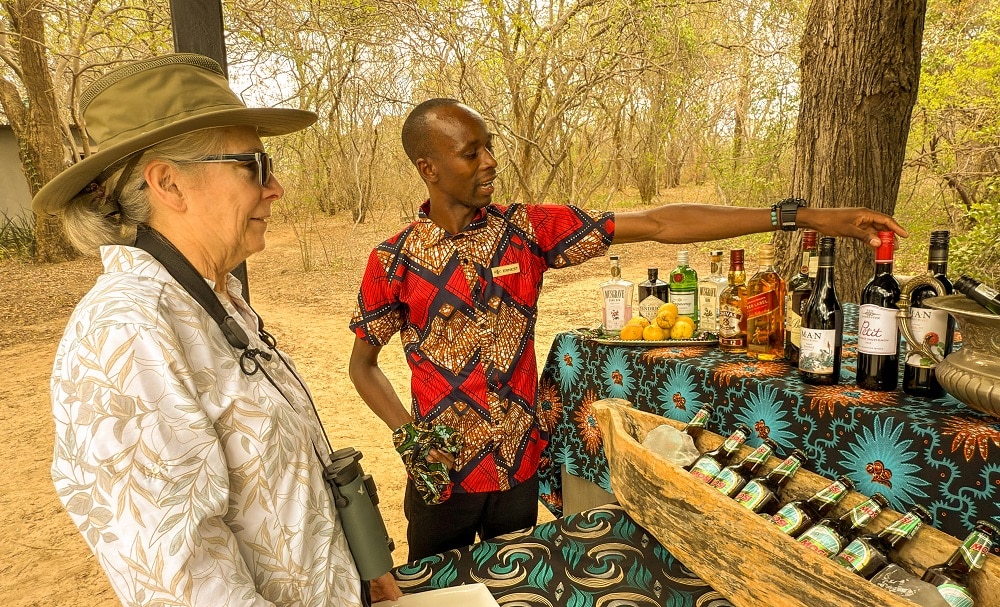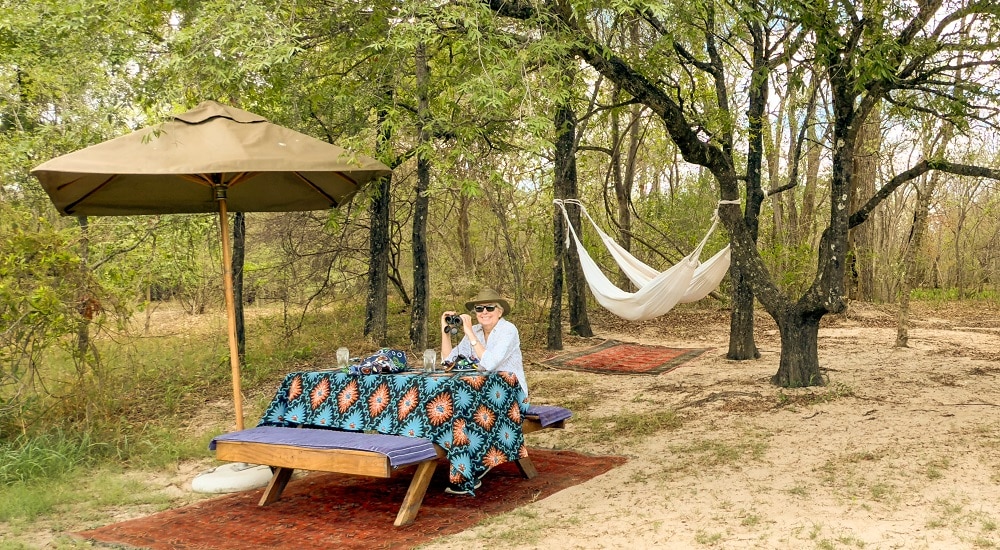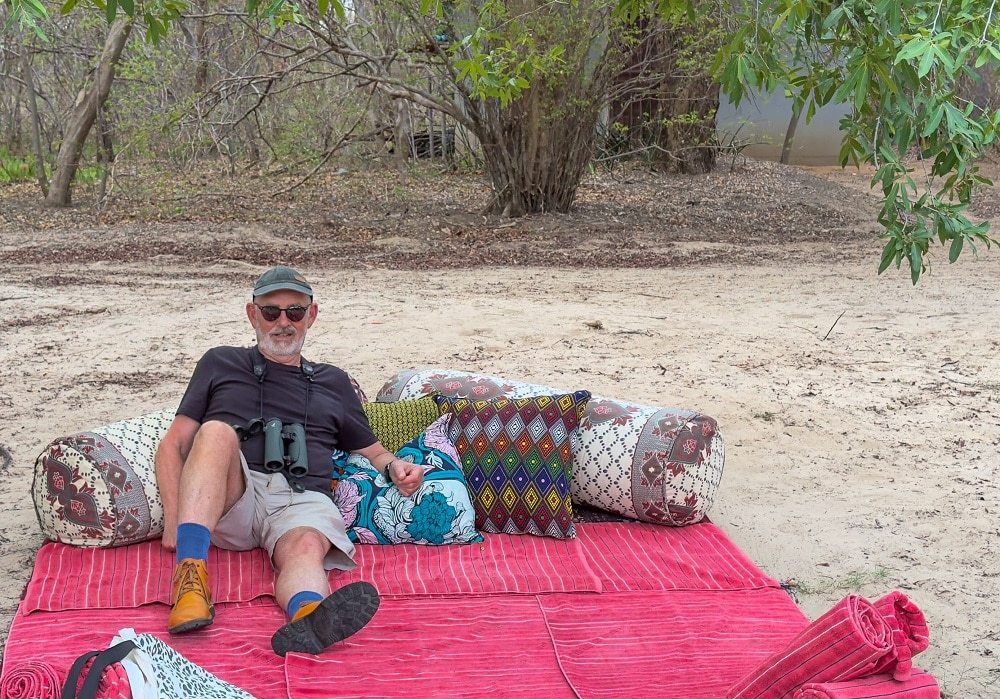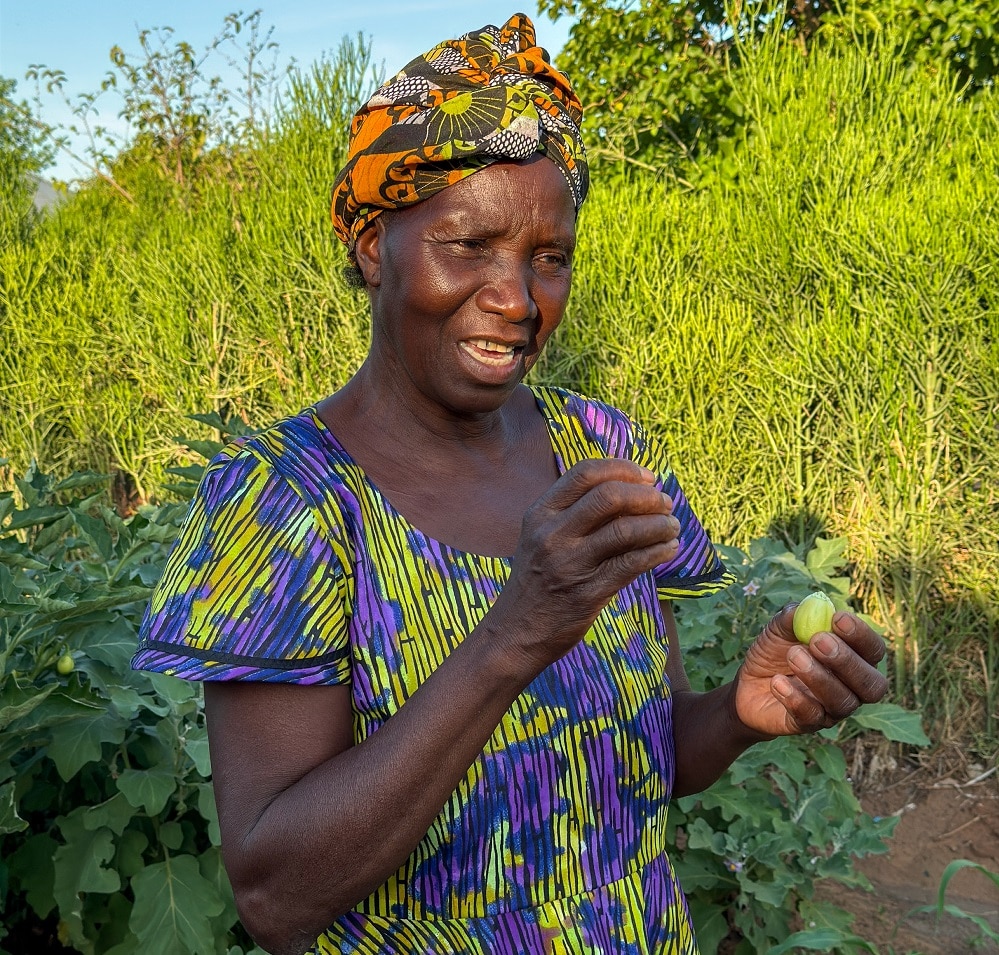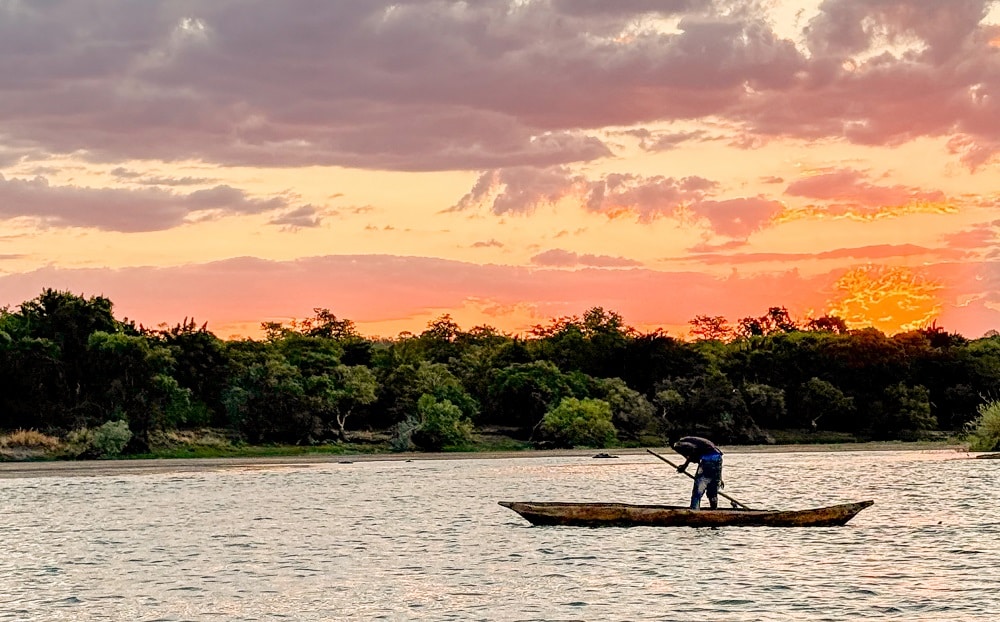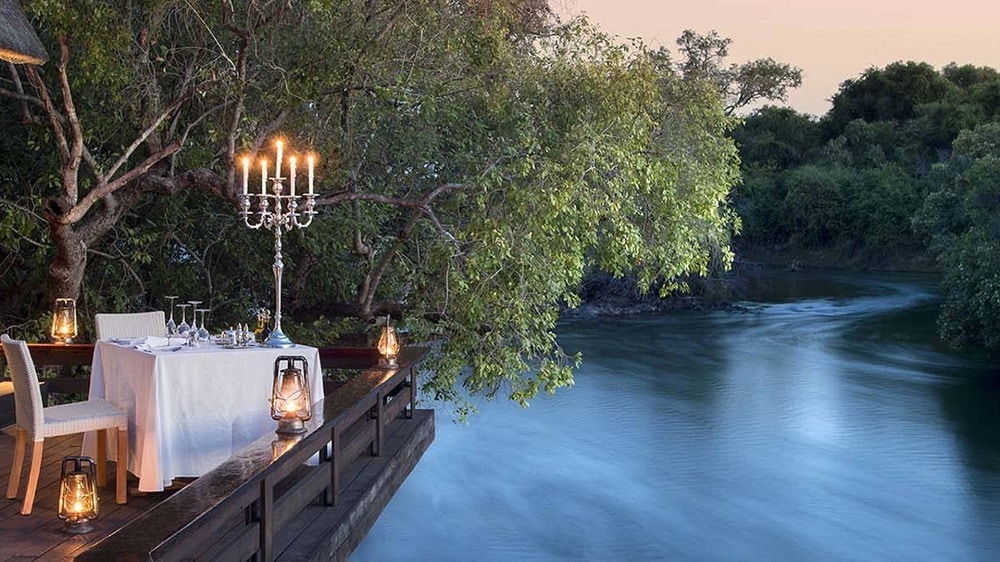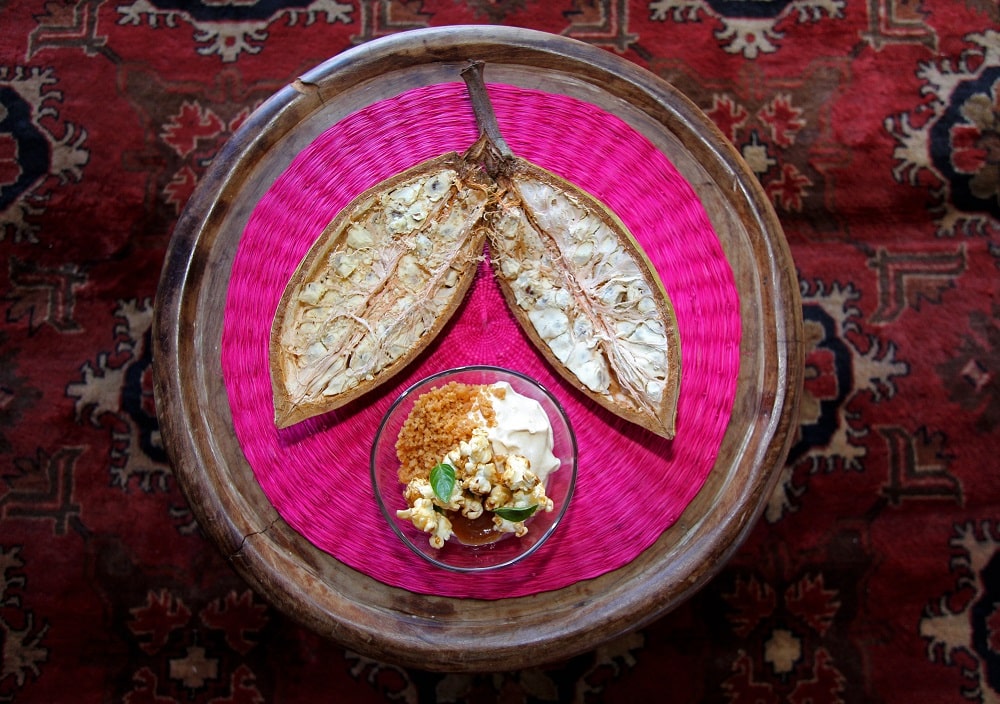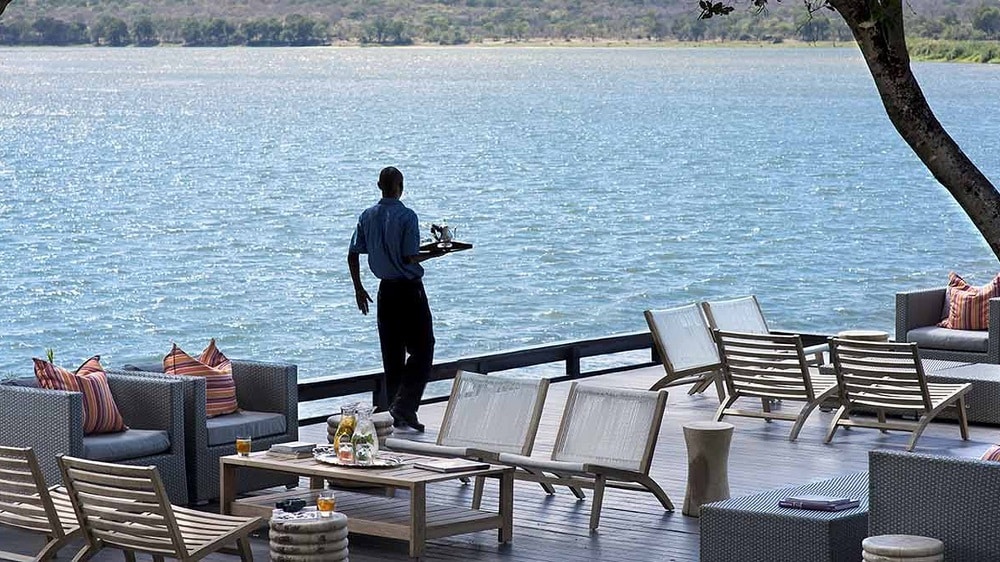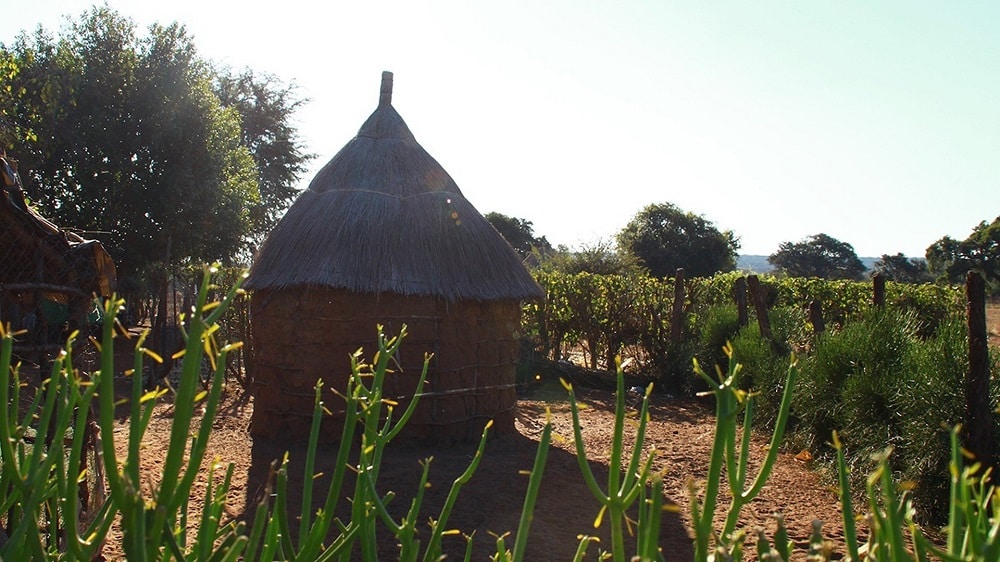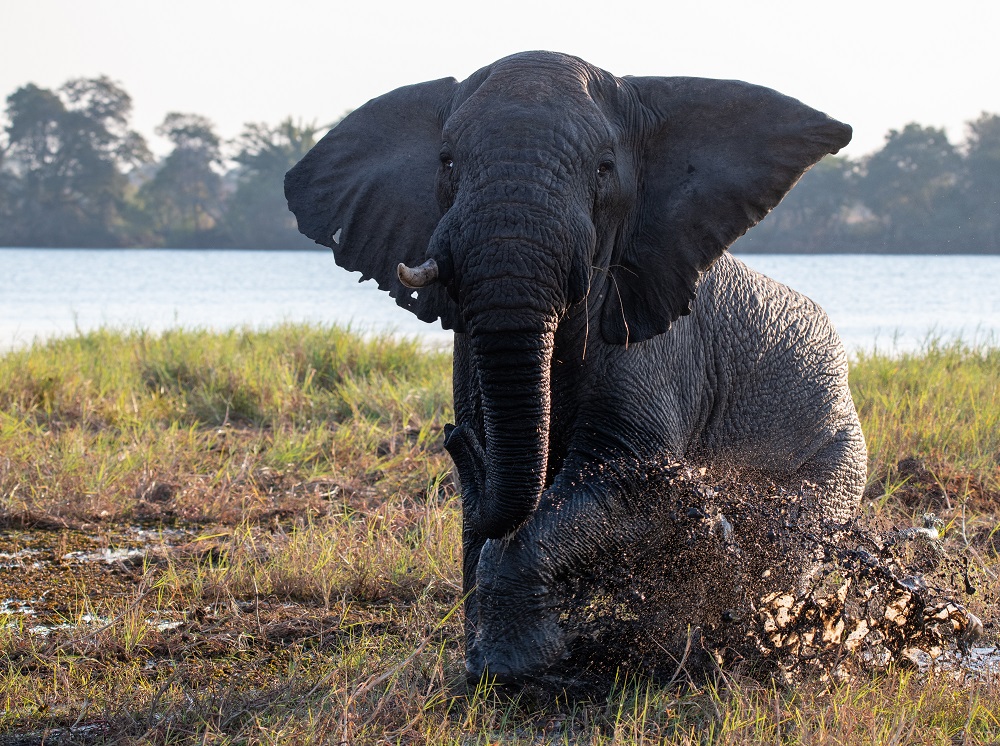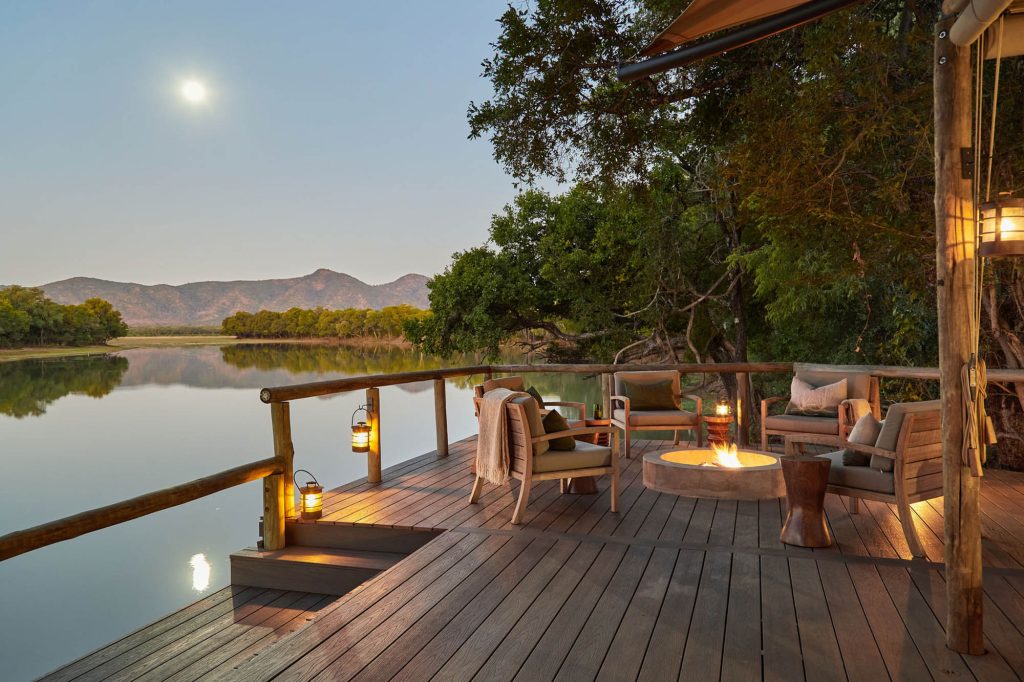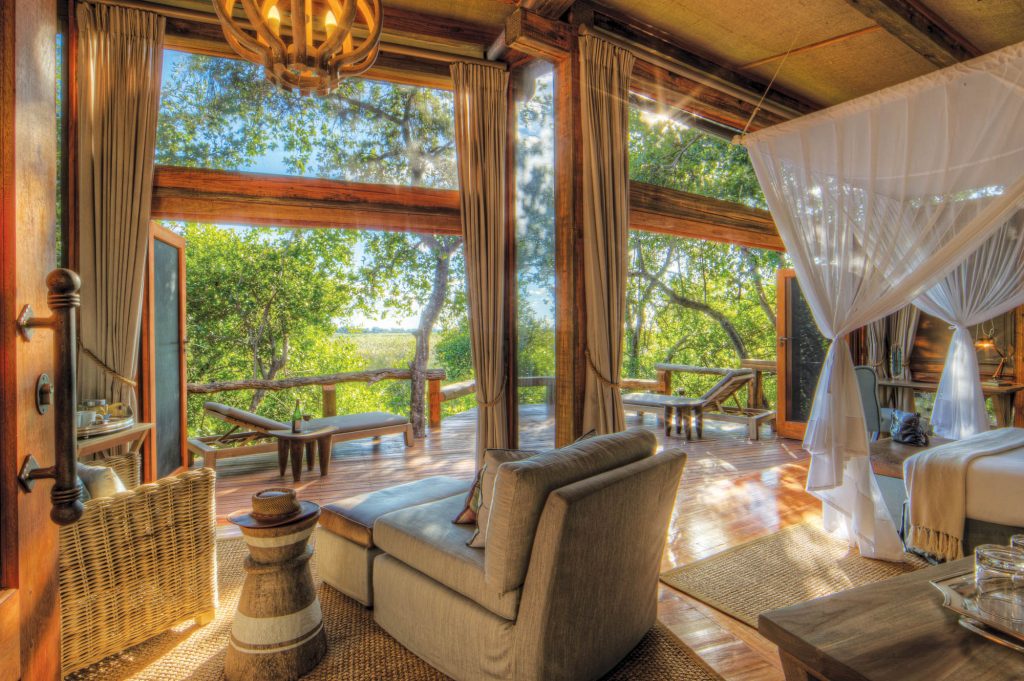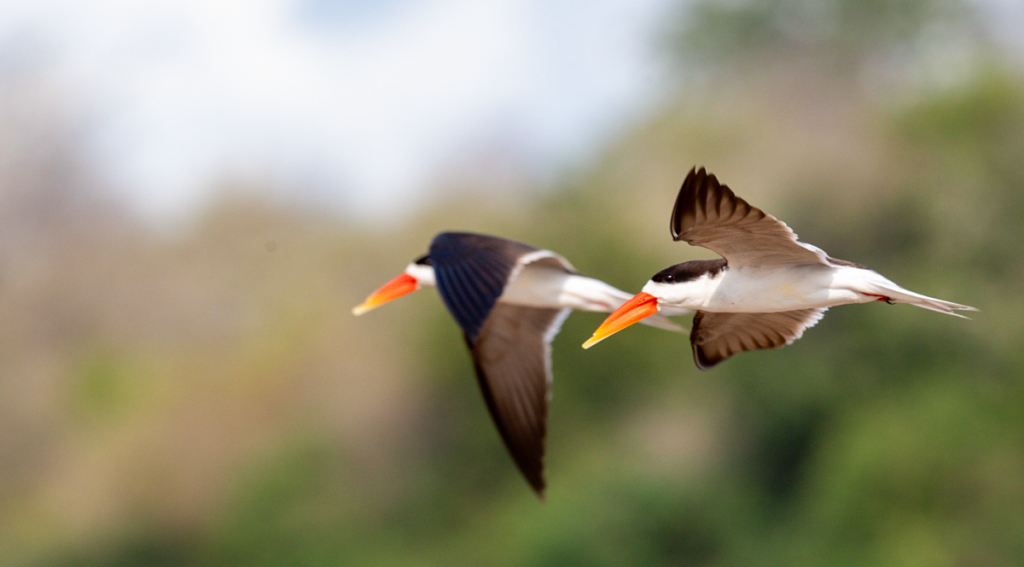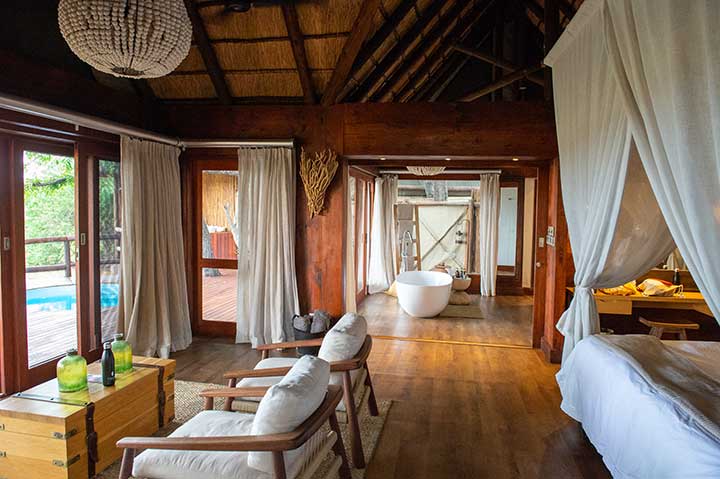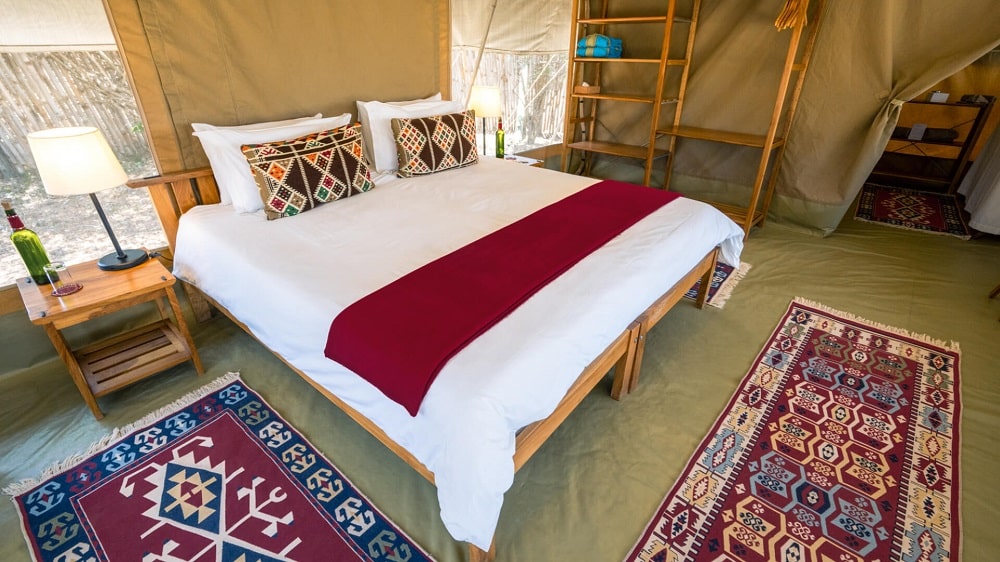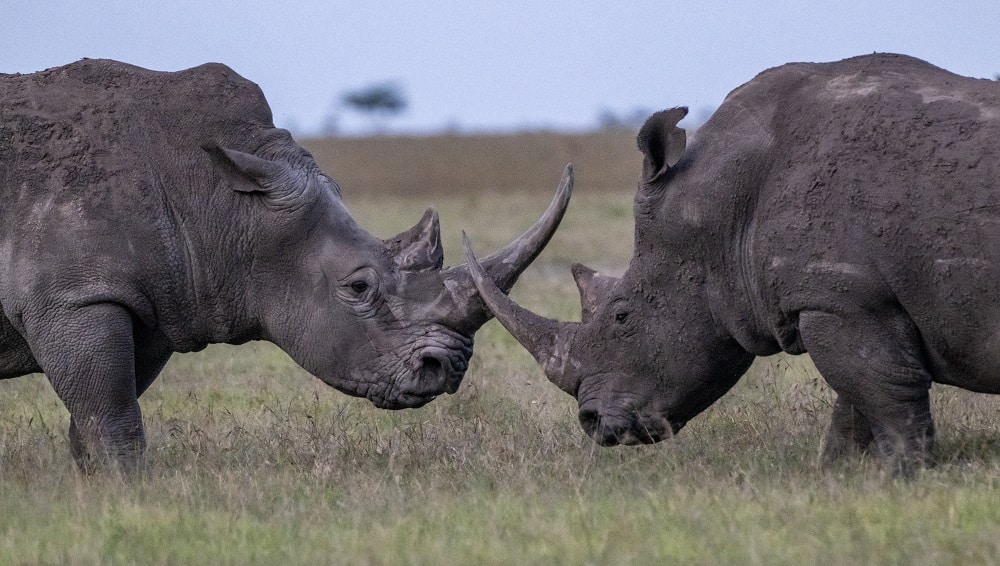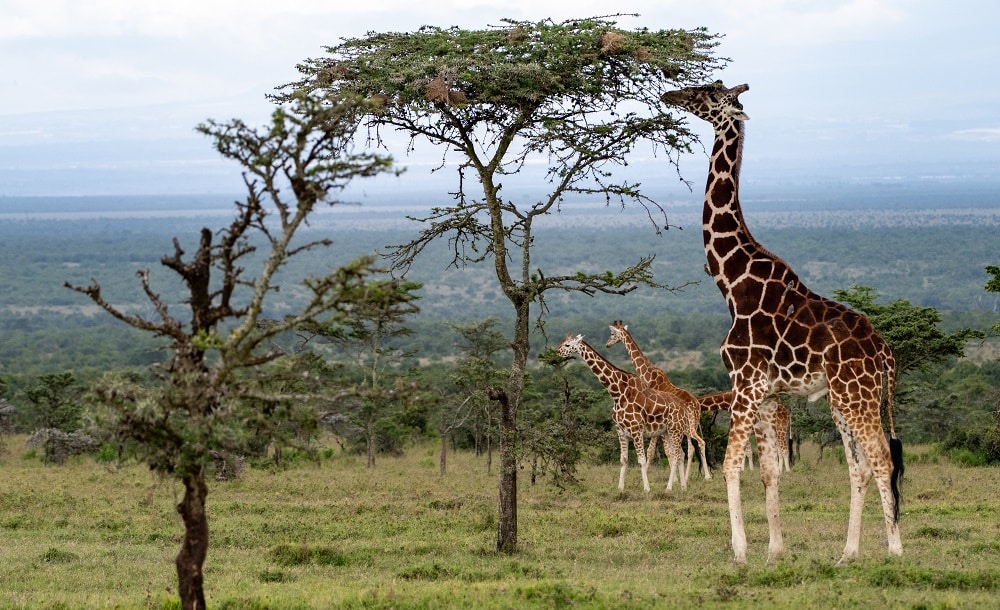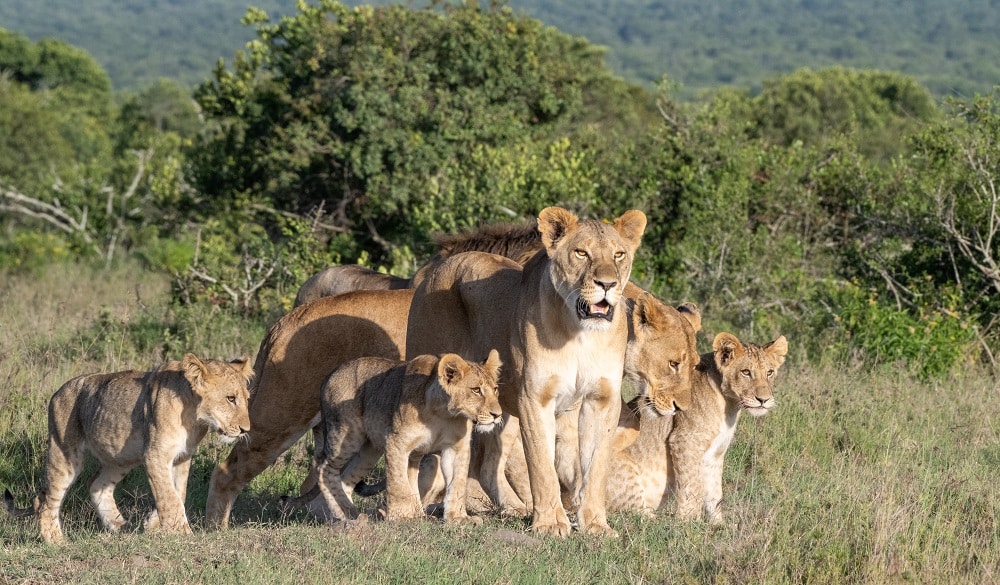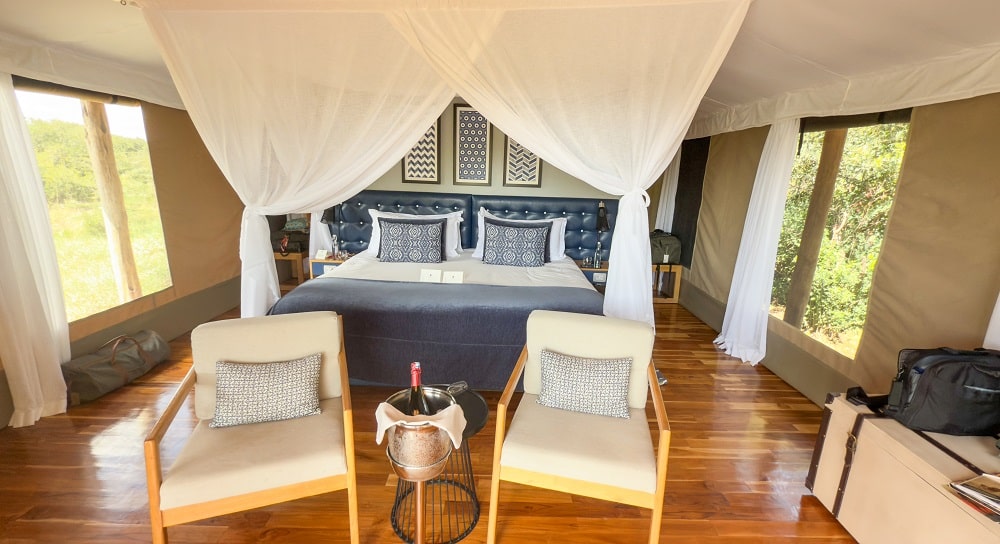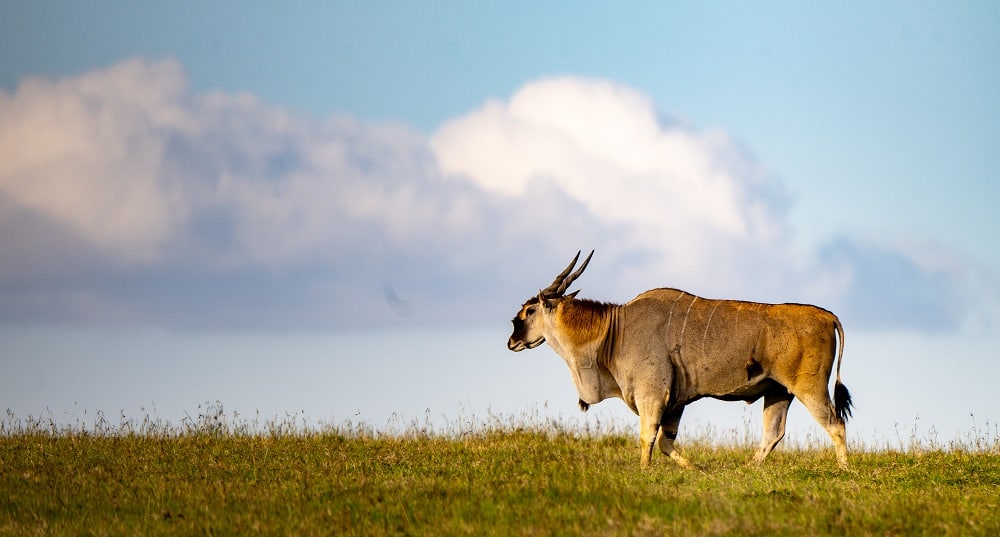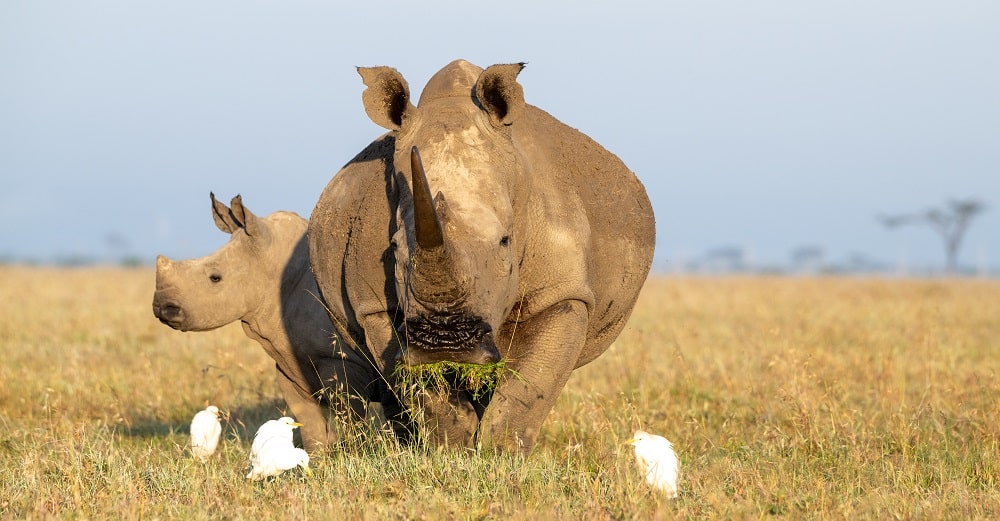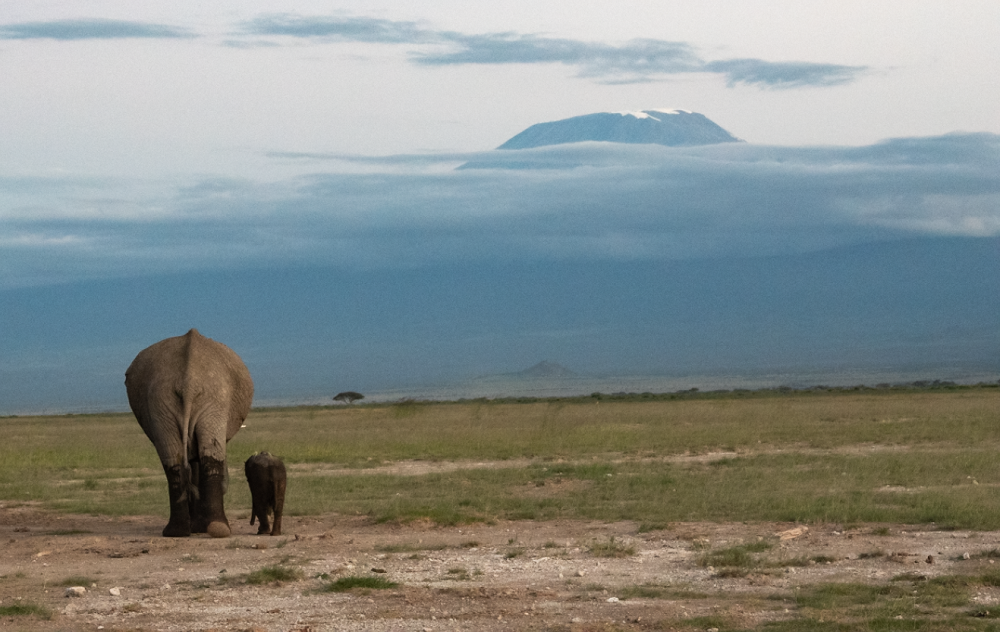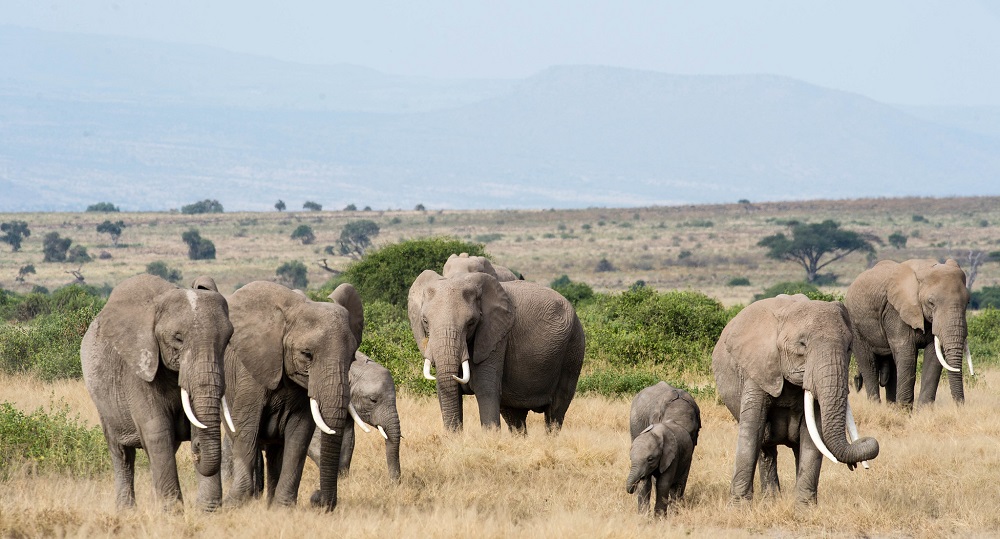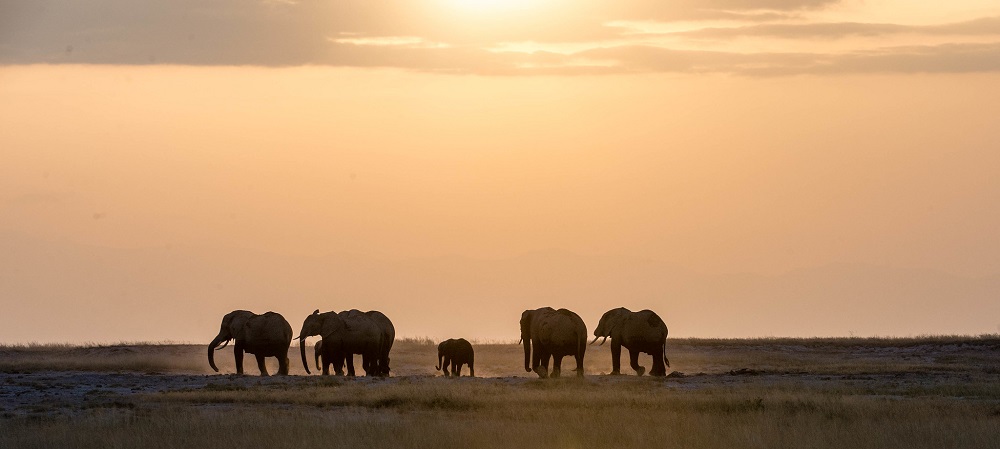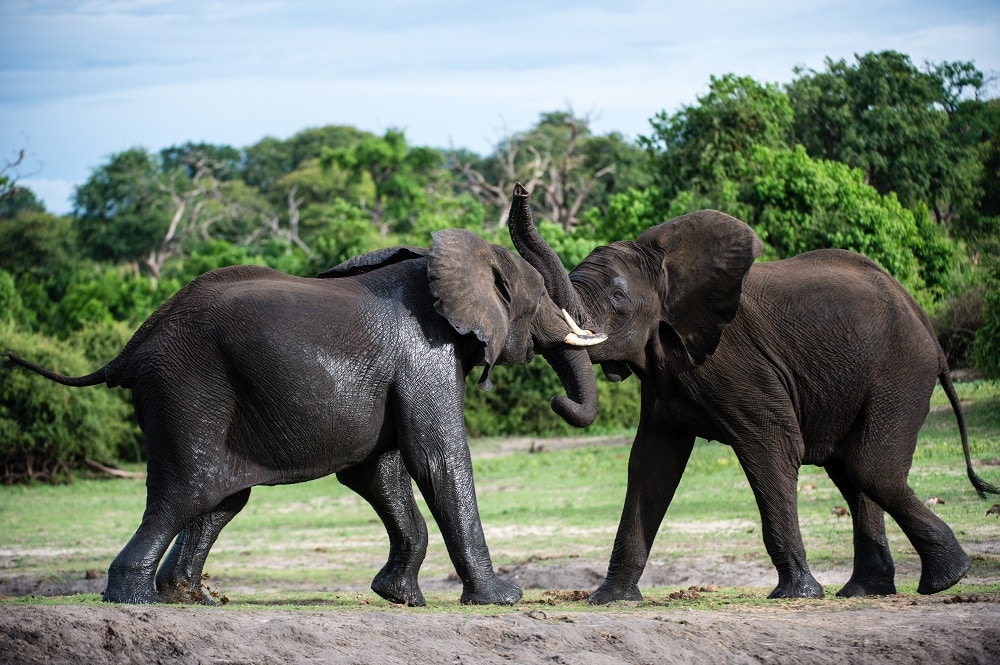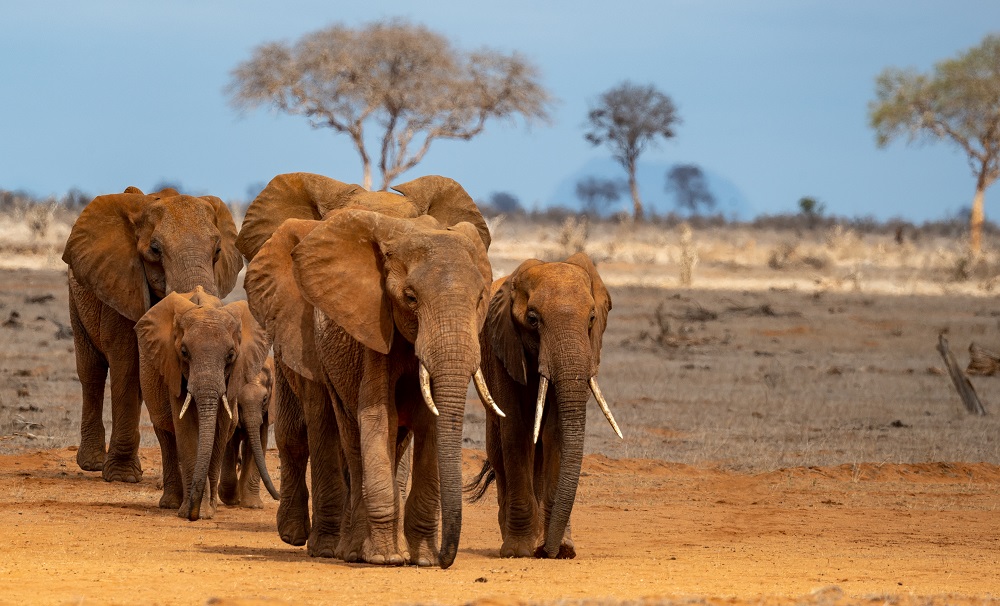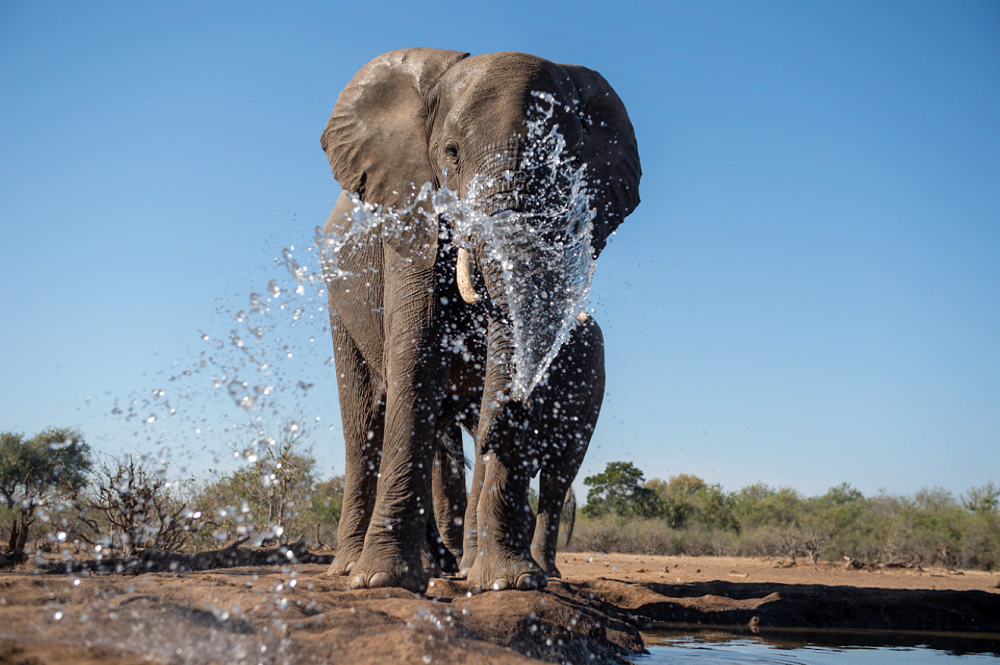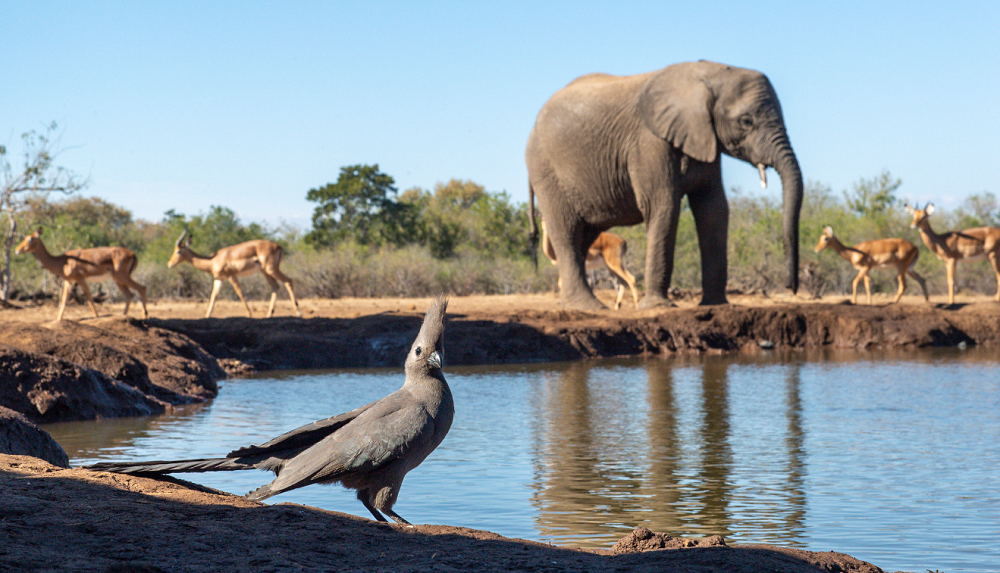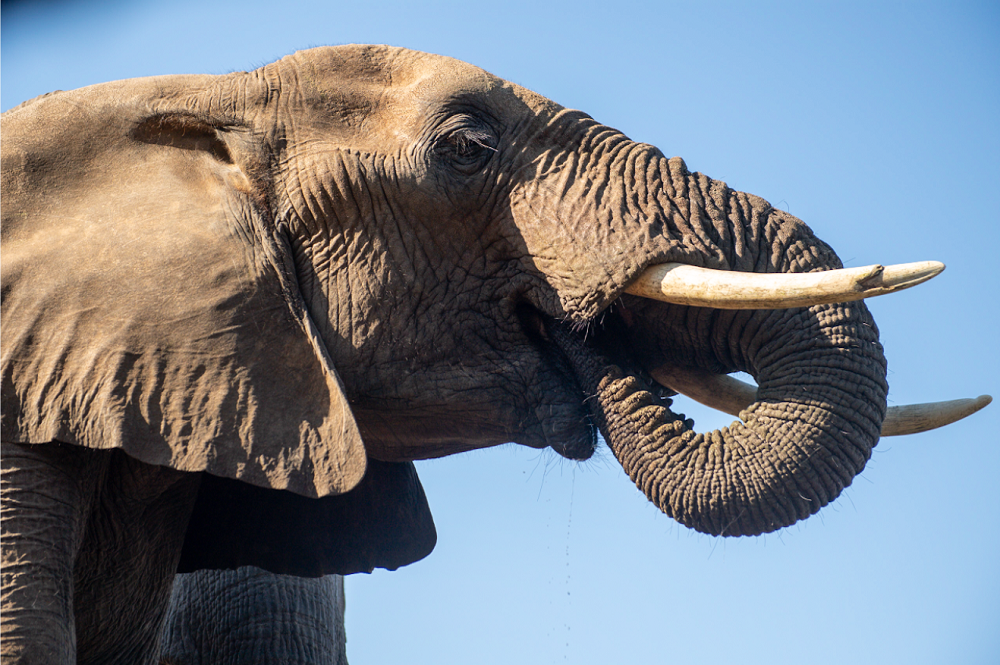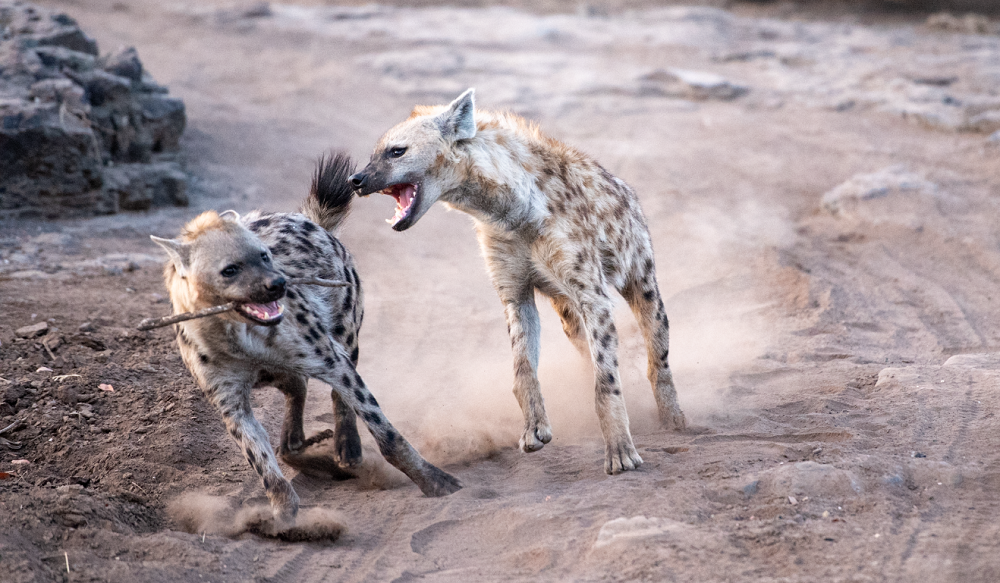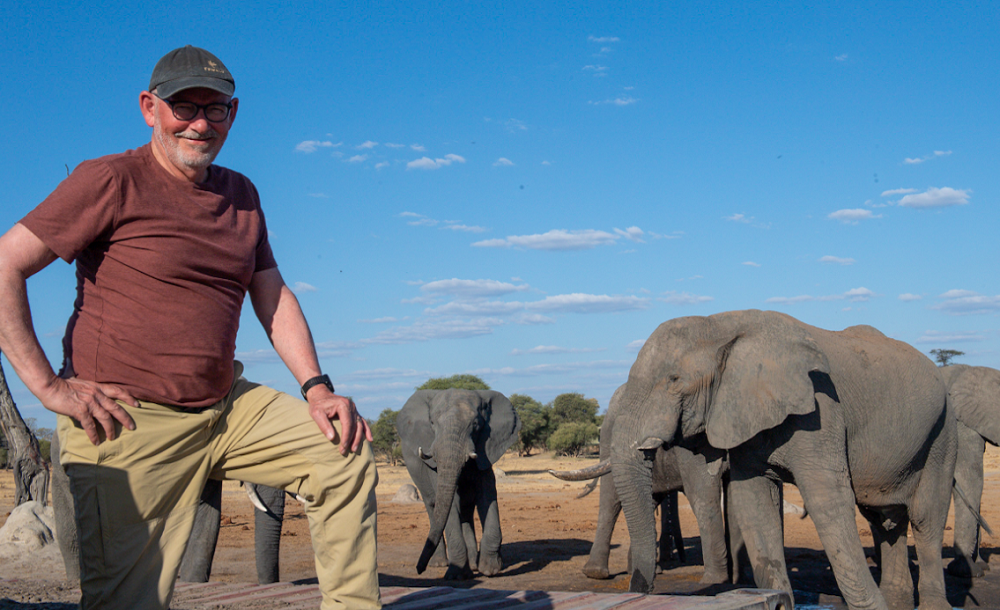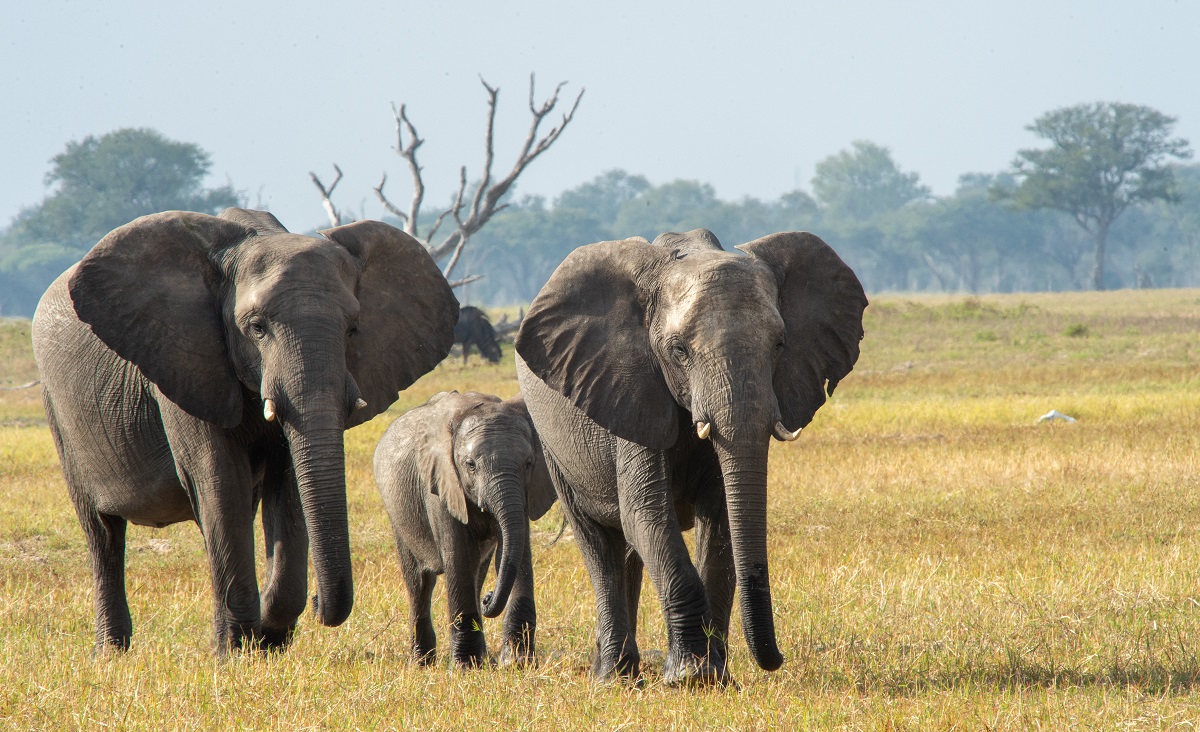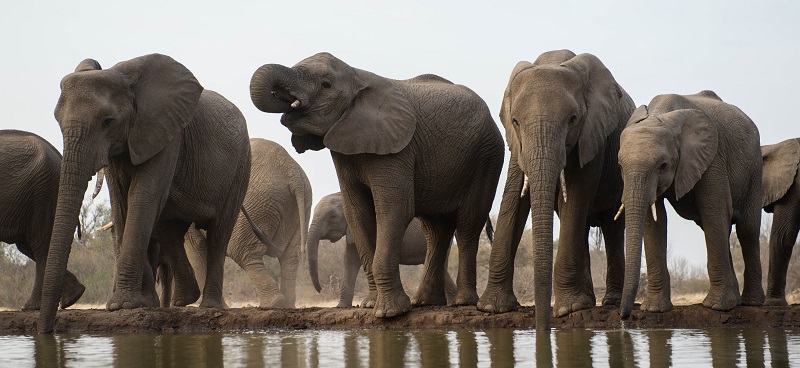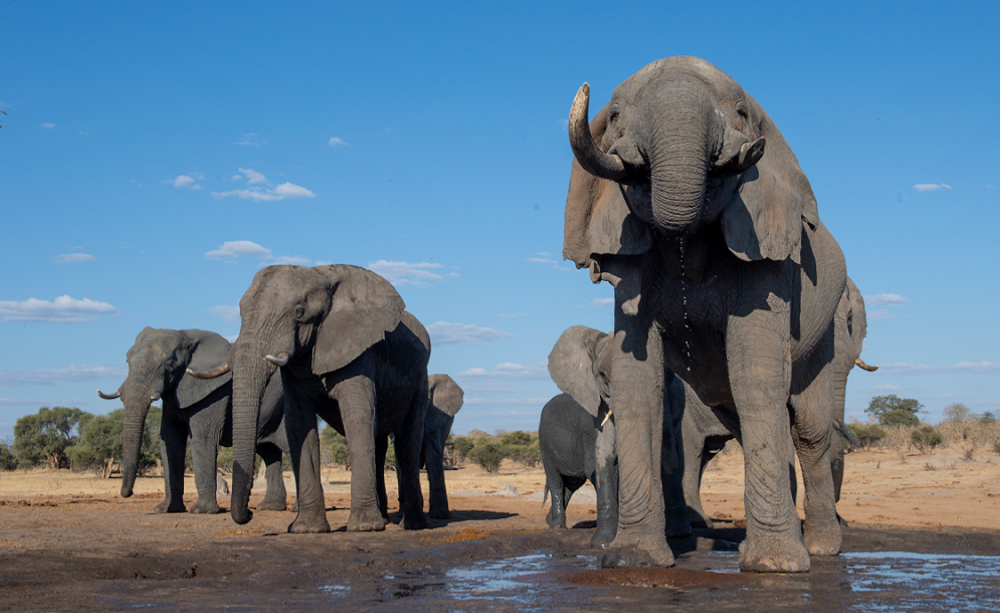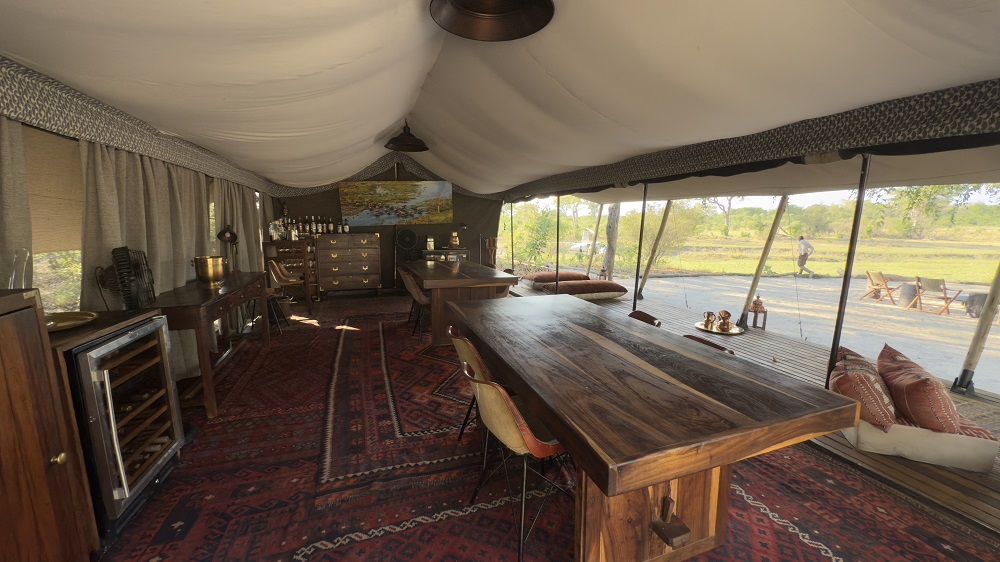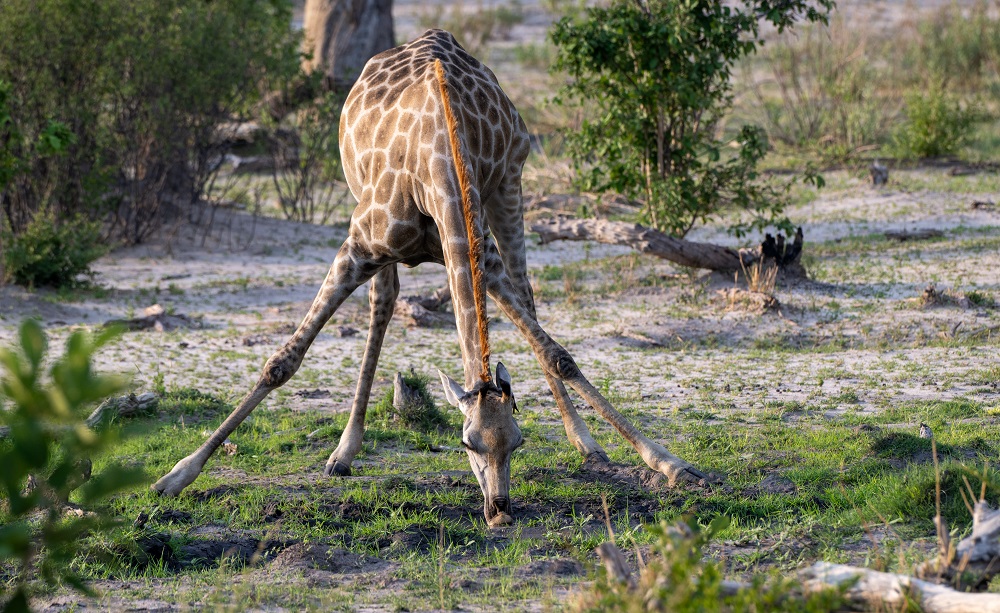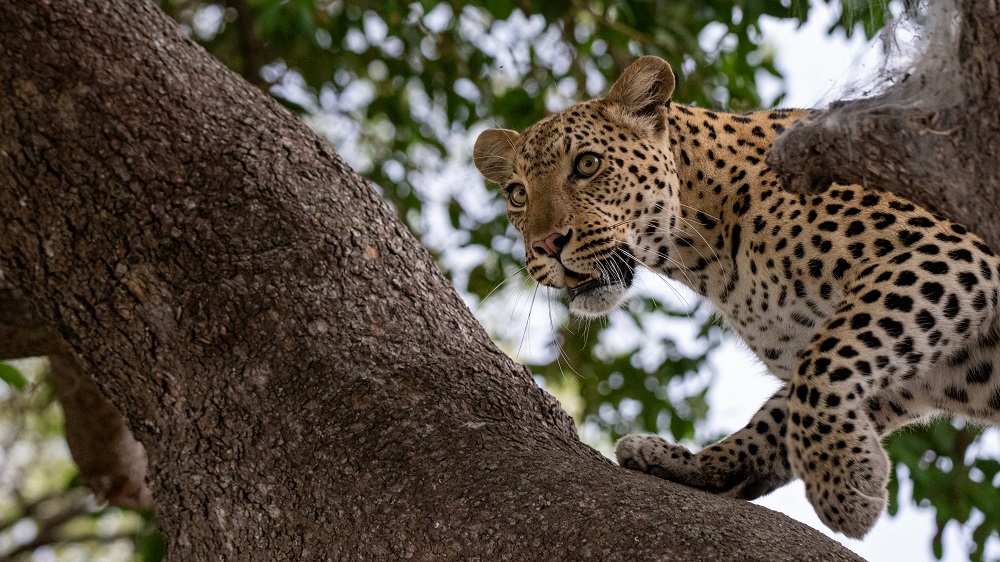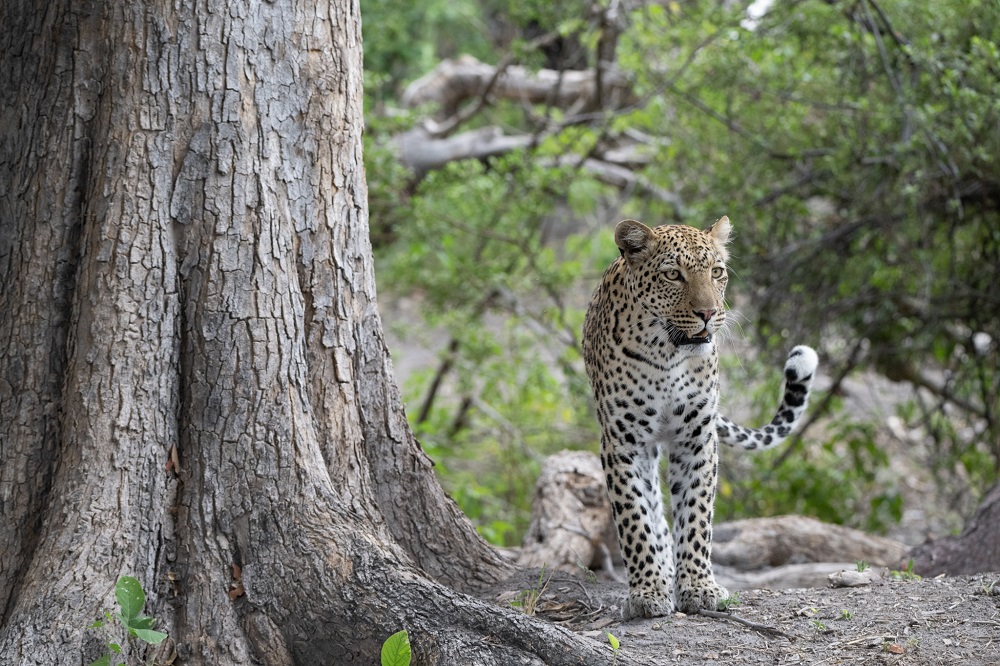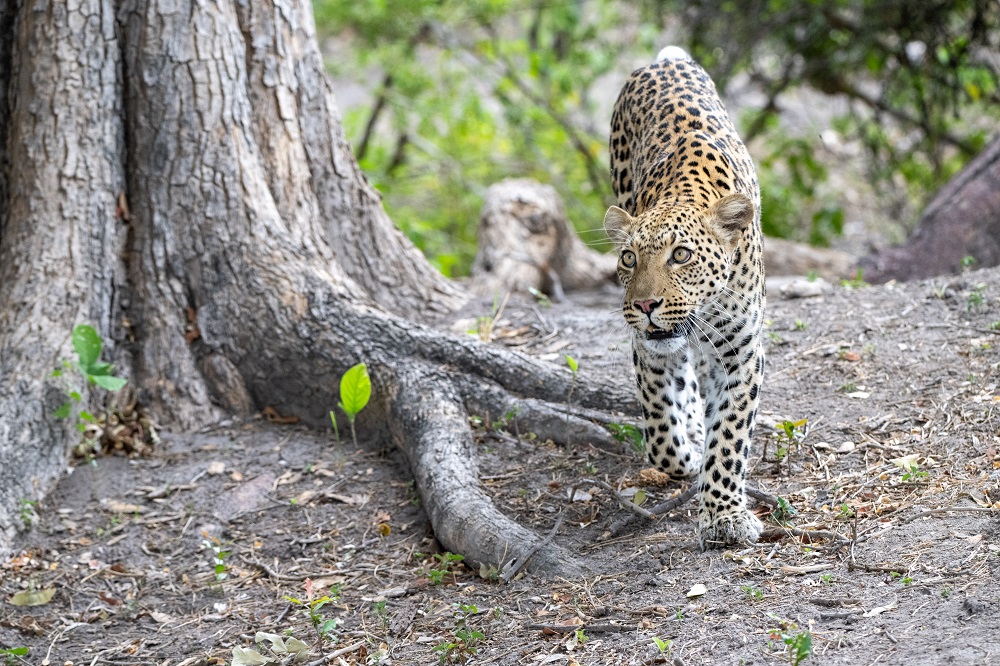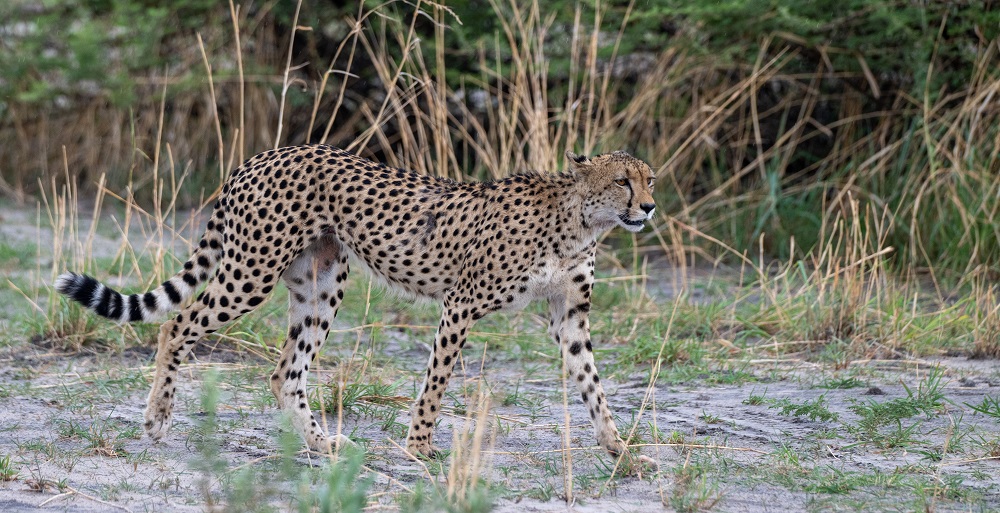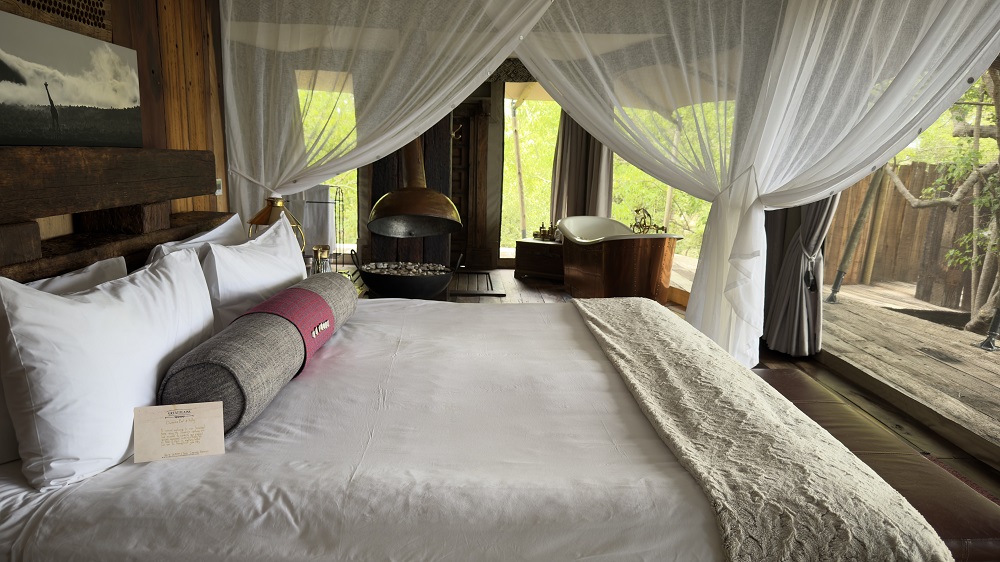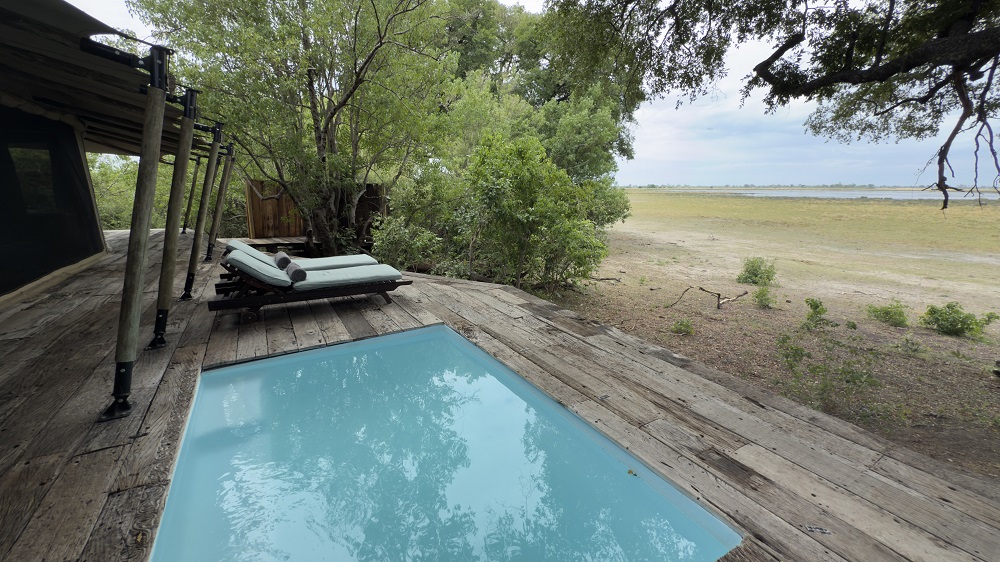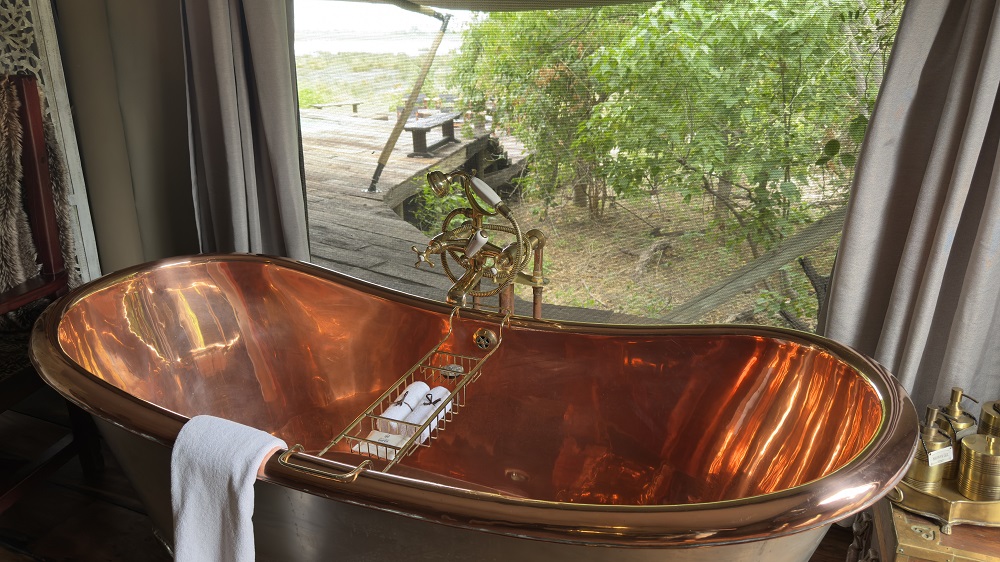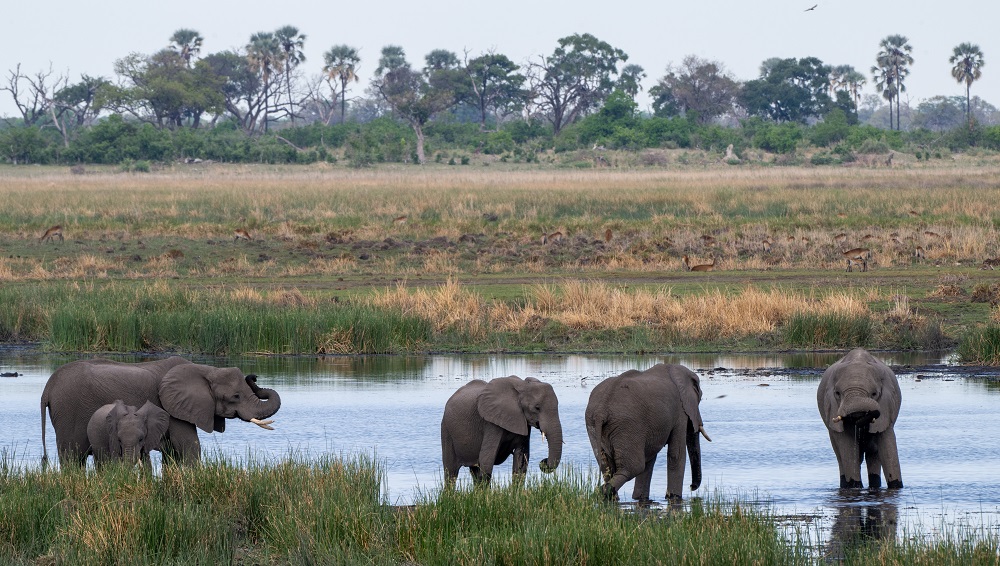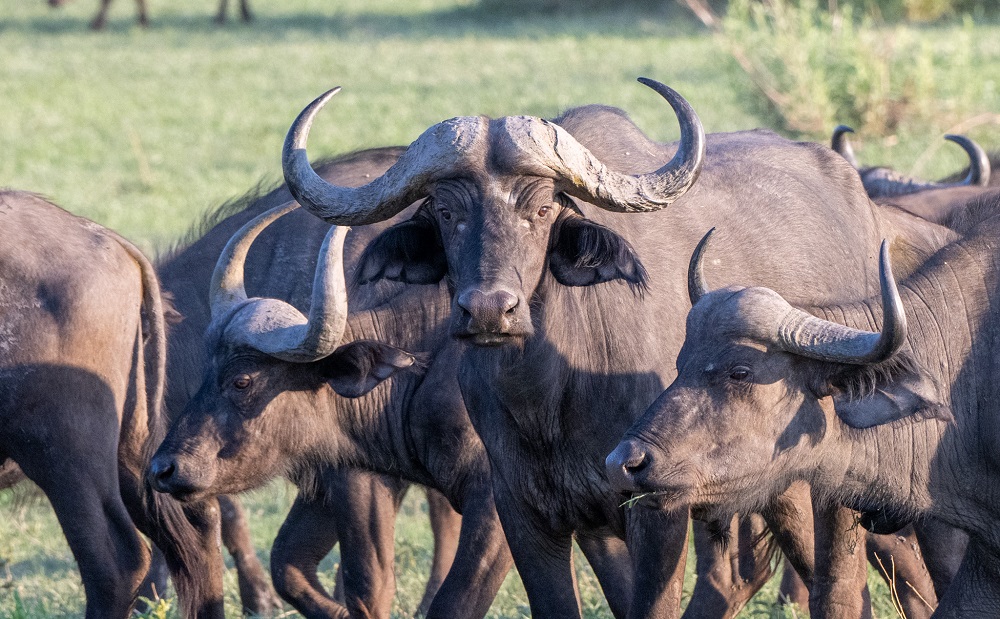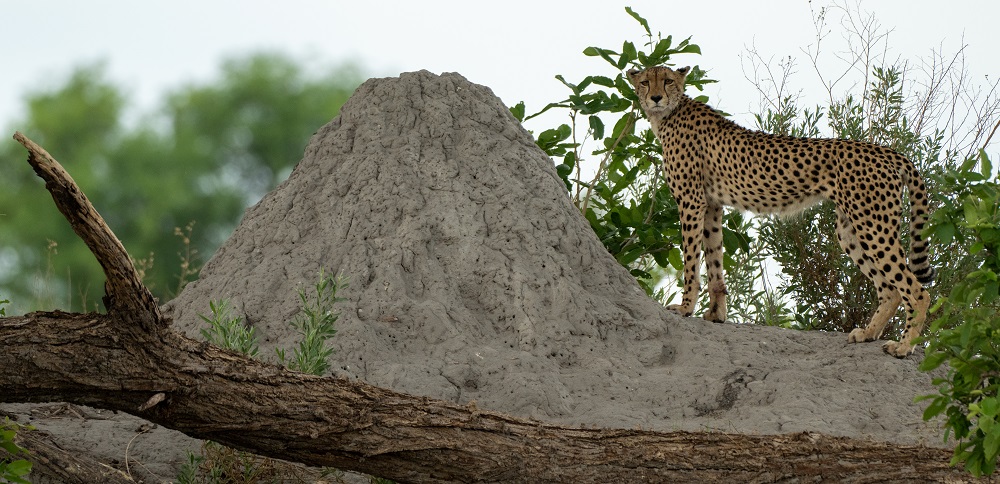A Warm Welcome at Royal Chundu, Victoria Falls Zambia
Listening to and soaking up the soft gurgling of the Zambezi River at 6.30 am on a cool summer morning last December at Royal Chundu Island Lodge in Zambia was about the best start to a day I’ve had in years. Adding to the sense of serenity and calmness which a setting like that engenders were the naturally soothing sounds of birdcalls. At least five or six different birds made it patently obvious that they liked being there that morning just as much as I did.
Few safari lodges anywhere in Africa look as good during the day as they do at night, when subtle lighting with locally made lanterns and candles can turn even a mediocre spot into a romantic getaway. Not so Royal Chundu. It looked great during the day and simply gorgeous at night. A lasting impression was the complete absence of distracting or otherwise bothering sounds. I heard the water – and the birds. And nothing else. Just the way it should be.
Our first stop at Royal Chundu was at River Lodge which has the most extraordinarily beautiful view over a broad stretch of the Zambezi with Zimbabwe on the other side. The Zambezi may have been at a low flow stage then (early December) but it was still one heck of a river, with a massive expanse of water in front of the lodge. Following our arrival briefing (which included some lovely iced tea and a much appreciated shoulder massage) we set off by boat to Royal Chundu Island Lodge.
With just four elegant – air-conditioned – rooms tucked into a dense stretch of riverine forest, Royal Chundu Island Lodge is a veritable escape from reality. It felt like there was nobody else around and that happened to be the case on the day. We were in that rarest of rare places, our own island paradise. Travel dreams do come true.
A short 10-minute walk took us to a lively picnic spot overlooking a set of rapids in the Zambezi. Just for the two of us the camp had set up what amounted to an adult playground. A picnic table with a couple of hammocks, a covered outdoor grilling and serving area with a well-stocked bar, a pizza oven and a large rug with soft, comfortable cushions. The perfect spot to enjoy a short siesta, the white noise of the Zambezi creating a near irresistible somnolescent effect.
Irresistible also describes the tantalizing array of items for lunch. Chicken pizza, vegetable pizza, freshly grilled Zambezi caught bream. Fillet of beef and grilled chicken. A mixed bean and chickpea salad with carrots, cucumber, sautéed onion, grapes, mango and nuts. We gave it our best shot.
Royal Chundu village visit
There are village visits and there are village visits. The not-so-great ones make you feel like an interloper, an alien checking out a strange new world. The good ones put you at ease right away, usually because of an exceptionally good local guide. We had just such a person show us around – Edith Mushekwa. By dint of her personality and leadership role in the village, Edith made the visit fun and we quickly realized that this village had taken organic gardening to the next level. Their cooperative organic garden, for example, utilizes cow dung, ashes and leaves for soil preparation. No fertilizer or chemicals whatsoever. Crop rotation enables them to maintain soil health and avoid the buildup of pests and diseases associated with specific types of plants.
During our casual stroll through the village, we had a fascinating introduction into the medicinal and commercial use of local trees, such as using the seeds of the mokete tree for oil. The hardwood of the same tree is also used for carving. The village produces a natural dye from the bark of the brown ivory tree. Many of the villagers carve items from redundant pieces of Zimbabwean teak.
On the boat ride back from the village we did a little birding and we we got lucky with several good birds including African skimmer, lesser jacana, pygmy geese, comb duck, African fish eagle, rock pratincole and a close-up display of a black egret ‘tenting’ its wings, a hunting technique.
Our day – or at least the daylight portion of it – ended as peacefully as it had started, drifting along the current of the Zambezi while being pushed by a cool breeze. It was cloudy so ‘sundowner cruise’ may not have been the best description. What it lacked in photo appeal it more than compensated with peace and quiet with not so much as another boat or even the sound of a boat anywhere. By 7 pm we were back at the jetty, ready to resume the eating safari.
A traditional dinner
The chef in charge of the culinary team preparing our traditional tasting menu was Chef Peter and he and his team absolutely bowled us over with the sensational range of flavors, textures, colors and aromas associated with the extensive traditional tasting menu. Relais and Chateaux properties like Royal Chundu are known for their high-quality restaurants and this meal was certainly in the ‘one-of-a-kind’ category.
Right off the bat? A delicate veloute of Kabulangeti beans. The word means ‘small piece of blanket’ and the comfort food connection is not hard to guess. These small brownish beans tasted somewhat like black beans. Delicious.
The second dish was dumplings with a dried fish filling; for the vegetarian in the party the chef had prepared a spinach wrap with mixed vegetable stuffing. Everything prepared from scratch and everything sourced locally.
I skipped the meat and fish offerings but even the most ardent steak lover might have taken a second look at the array of vegetarian options:
- Maize nshima (local version of polenta)
- Millet nshima
- Okra with sweet potato leaves
- Aubergine impwa (‘egg’)
- Spinach and ground nut melange
- Small local beans
- Masembe pudding, the local take on sago pudding
We didn’t finish everything but went to bed happy in the knowledge that none of the buffet items would go to waste.
Breakfast overlooking the Zambezi
Our culinary exploration at Royal Chundu didn’t end with dinner. We jumped right back into it the following morning, starting with an excellent decaf Americano, with a vanilla muffin or milk scone with strawberry preserve on the side. Your choice. Not to forget the locally-made peanut butter and orange marmalade with freshly made toast. Just like at dinner, all the fresh vegetables and herbs used in the preparation of the meal were supplied by neighboring villages or regional farms.
We really didn’t know where to start – or end – with so many choices:
- A fresh fruit platter with delectable watermelon, pineapple and mango
- Choice of two types of creamy traditional porridge or oats, served with wild honey & toasted ground nuts
- French toast or flapjacks
- A traditional breakfast with eggs, bacon, tomatoes and mushrooms
- Eggs Benedict
- Eggs Florentine
- A 3 egg omelette
A true community-run lodge
During an all too short site inspection at Royal Chundu River Lodge, general manager Aggie Banda filled us in on the remarkable manner in which the lodge – literally from day one when it opened in 2010 – has been community-run. Practically the entire Royal Chundu team are Zambians, including the managers. And most of the team members live in two nearby villages – Malambo and Muluka. Royal Chundu is a community-run lodge in the full sense of the word. The lodge provides training to the community, it sources its food from Zambia (mostly supplied by local fishermen and village gardens) and it supports the village gardeners through a Seed Project.
To the extent possible, Royal Chundu looks to its own sphere for suppliers – such as seamstress work for their chitenge uniforms, cushion covers, doormats and dish covers; woodwork for their wooden doorbells; and artwork on the walls. The Royal Chundu staff have created spin-off businesses from the lodge, such as transfer services for guests as well as courier services delivering firewood and fertilizer.
Zambia in 2025 and 2026
Our short visit to Royal Chundu, which is of course on the Zambia side of the Zambezi River, reminded us that we may have been neglecting Zambia – as a safari destination – over the last few years.
There are safari destinations which attract hundreds of thousands of visitors annually like Kenya, Tanzania and South Africa. And then there’s Zambia in central Southern Africa which attracts a relative handful, by comparison.
Zambia is a large Southern Africa country (about the size of Texas) with every bit as much diversity as Kenya or South Africa. Which says a lot. It offers a multitude of activities, scenic highlights, wildlife viewing opportunities and cultural interaction. With several new and exciting safari options in the offing for the 2025 and 2026 seasons, we will definitely be paying closer attention to Zambia. So if you ask us for a Botswana itinerary suggestion you’ll get it, but you may get a Zambia one as well!
Our Fish Eagle Safaris team have visited Zambia regularly over the years, and we’re ready to answer any questions you may have and to suggest a couple of Zambia safari itineraries. Perhaps in combination with one or more other areas in Southern or East Africa. Please leave a message at 713-467-5222 and someone will get back to you right away, or email Bert at bert@fisheaglesafaris.com.
Some photos courtesy Royal Chundu
Kenya’s Laikipia Plateau: Ol Pejeta Private Conservancy
Ol Pejeta is a Masai phrase which means ‘the place of burning,’ likely hearkening back to a time when pastoralist communities eradicated ticks by burning the grassy plains which dominate the area. During the course of a few days spent at four different safari camps in the Old Pejeta Conservancy in Kenya’s north-central Laikipia region, we fortunately experienced neither ticks nor fires. Rather, the visit highlighted a few key differences between Southern and East Africa and Botswana and Kenya in particular.
For one thing, we started seeing rhinos, both black and white, right away. They are common, if not downright abundant, in several of Kenya’s private conservancies including Ol Pejeta and Lewa-Borana. Elsewhere in Kenya, rhinos can also be seen in Loisaba Conservancy, in Meru National Park and Nairobi National Park, and there is a significant black rhino presence in the Ngulia Rhino Sanctuary within Tsavo West National Park.
Unlike many of the game reserves in Southern Africa, the rhinos of Ol Pejeta, Lewa and other parts of Kenya are not dehorned so you will see them running around with their completely intact, beautiful horns – ready to defend themselves when necessary. In most of the private conservancies in Kenya it is not unusual to see from five to seven or eight mammals at the same time. On more than one occasion we had rhino, buffalo, giraffe, gazelle, zebras and jackals in the same field of view.
Just like the private concessions in Botswana, the Kenya conservancies offer a more exclusive safari experience as access is restricted and a wide range of activities are available including night drives, walking safaris and off-road driving. Where they differ is the degree of community involvement. The Kenya conservancies operate as integrated conservation entities, managing a healthy habitat for wildlife and livestock. They work closely with surrounding communities in a manner which blends commercial income from tourism as well as agriculture.
Another notable difference: on safari in Botswana it is often downright impossible to see signs of civilization as we know it anywhere in the private concessions in northern Botswana. No power lines, no fences, no water towers, towns or even villages. Not so in Kenya. Some of the private conservancies border on national parks while others are enclaves within populated areas. Take a few photos at Lewa or Ol Pejeta and invariably, there will be structures in the background. In essence, there is no difference in the safari experience whether you’re 5 miles or 50 miles from the nearest power line, but ‘civilization’ is all too visible in the East African conservancies.
It is of course part of the conservation model: a cooperative effort involving local communities to preserve suitable habitat for wildlife. To be successful, all the partners have to be winners. Which means there will be some agriculture going on, visible to the human eye mostly in the way of cattle herds or sometimes flocks of sheep or goats. Beyond serving as the living livestock ‘banks’ for the local people (whose wealth is largely measured by livestock ownership) these animals contribute to the health of the habitat by keeping the grass short where and when needed and by supplying free natural fertilizer. Livestock – notably cattle- also provide an additional revenue stream for the conservancy.
One other thing about Ol Pejeta that is practically impossible to miss is the looming presence of Mt. Kenya, Kenya’s highest mountain peak, often clearly visible to the south. Sometimes shrouded in mist, sometimes not, Mt Kenya is always there like a watching sentinel, a visible reminder of the landscape diversity which Kenya is fortunate to have. Over the course of four days in Ol Pejeta we had some great views of the mountain, with the single most memorable moment being observing some zebras in the foreground, with a misty mountain behind. My photography skills for once didn’t measure up to the challenge – silhouettes are always tricky!
Ol Pejeta Bush Camp
Our first stop in the conservancy, Ol Pejeta Bush Camp, felt comfortable and warm from the word go. Sitting out on the verandah overlooking the Ewaso Nyiro River while being given the usual arrival briefing, a good sized herd of elephants was grazing right on the opposite bank of the river. Later on, we saw several buffalos and hippos from the same spot, and other guests mentioned a leopard which was seen walking there. The delicious al fresco lunch on arrival set the tone for the quality of the meals. We also liked our tented room – one of only eight in this small, solar-powered camp.
On our very first game drive in Ol Pejeta we encountered a remarkable number of rhinos including several black rhinos and one group of four white rhinos. It was no different the following morning and, without having to try too hard, I captured some of my best photos of both black and white rhinos in at least a decade. Over sundowners that afternoon a large male white rhinoceros appeared on the scene while we were watching four white rhinos grazing. The new arrival became agitated and ended up in an altercation with the largest individual in the group of four. As the light slowly faded, the two rhinos were still in a standoff, head to head, their massive horns just inches away from each other.
Kicheche Laikipia
What would be better than spending a few days at Kicheche Laikipia camp in Ol Pejeta? Combining it with a few days at a Kicheche property in the Masai Mara to qualify for Kicheche’s ‘stay 6, pay 5 nights’ special offer. Top-notch guiding, excellent all-around hospitality and thoughtfully designed rooms at all of the Kicheche properties make for a fun and absorbing safari experience with lots of animals and few other vehicles to be seen.
At Kicheche Laikipia we felt at home right away, with every member of the team doing whatever they could to make our short stay special. The attention to detail, the ‘make your own pizza’ lunch, the sense of privacy and exclusivity with just six rooms tucked away into a dense thicket. From the cozy dining tent we observed a good number of animals coming to drink at a pond, a hundred meters or so from camp. Among others we saw eland, buffalo, elephant, many birds, impalas and gazelles – all while enjoying Kicheche’s excellent food.
Our afternoon game drive out of Kicheche was another winner with several more excellent rhino sightings and finding a large pride of 26 lions – with lots of cubs of various ages. It was as entertaining and downright spectacular as any experience we’ve ever had with a group of big cats. Observing the youngsters ‘hunting’ each other, recognizing the affable attitude of particularly the adult females towards the young ones, letting the babies crawl all over them. Above all, seeing right there in front of us how cohesive they were as a pride, with muted contact calls and visual contact keeping them all moving as one, apparently all on their way to some predetermined spot. We were not unhappy to see the last couple of tails disappear into a thicket. We enjoyed our views and took our videos and photographs. It was time to let the lions be lions in private.
Sanctuary Tambarare
An extended game drive on our first day at Sanctuary’s Tambarare Camp illustrated just how diverse the Laikipia plateau can be. This beautiful expanse of broad, undulating plains, rolling hills and scattered rocky outcrops offers something new and interesting around every corner. Driving from the open savannah area into a huge whistling acacia thorn tree forest, we suddenly started seeing lots of small groups of the stunning reticulated giraffes. Without doubt my favorite of the giraffe species with their boldly delineated orange-red spots, separated by cream-colored lines.
Later on during the same drive, we were watching a large pride of lions which had brought down a buffalo the previous night. As the sun was setting, several of them made their way to a watering point, one after the other. Just then, a black rhino started heading for the same trough and it initially made a mock charge towards one of the lions. When a couple of the other lions showed up the rhino figured that discretion was the better part of valor and it disappeared. Our guide didn’t think that the lions would actually have taken a serious interest in the rhino, but it certainly got us to pick up our binoculars.
Our tented room at Tambarare was just about perfect. Elegantly appointed with just enough space, it had a separate shower and toilet, his and hers wash basins, ample luggage space, recharging points, and adequate lighting. And lo and behold, there was an electric blanket which we put to good use. The level of food and service at Tambarare was top-notch and we were totally spoiled with the choices and options. A specially prepared dish with ugali and maharagwe (essentially red beans in a coconut-based sauce) was outstanding!
Being close to the equator, there are no wild swings between summer and winter days and summer and winter weather in much of Kenya. Altitude is generally a more important weather determinant than anything else. Being at an altitude of more than a mile high, Tambarare and for that matter all of Laikipia is always temperate and generally quite nice, with daytime highs around 80F and average lows rarely below 50F.
Our team at Fish Eagle Safaris have been including a few days in the Laikipia region with several Kenya itineraries lately, with great success. If you’re considering an East Africa or Kenya trip, please reach out to Jason at jason@fisheaglesafaris.com for some suggestions on how – and when – Laikipia might best form a part of your trip.
African Safari Update
A Few of Our Favorite Elephant Destinations
Over the last thirty years plus since Fish Eagle Safaris came into being, our team members have been fortunate to observe thousands of elephants. Even so, there is not one among us who will ever tire or become bored of finding and observing these amazing beasts. They are at the heart of a successful safari and like so many other passionate wildlife enthusiasts, we can and do watch them for hours on end. There are elephants in many areas of eastern and Southern Africa, but these five locations are standouts:
Amboseli National Park
Two things elevate the elephants of Amboseli National Park into superstar status. The one is the fact that they – alone among all the many thousands of African elephants – are the only ones which live and breathe in the rain shadow of Mt Kilimanjaro. With a little bit of luck and skill – and a guide who will already be primed to do this – you too can take a photo putting the elephants between you and the mountain. It’s not too difficult and the results are stellar.
What is the other thing about Amboseli elephants which makes them special? Their white tusks. But don’t all elephants have white tusks? Indeed they do but if there were a dental whiteness standard for elephants as there is for human teeth, then the Amboseli tuskers would be practically off the charts on the bright side. The reason? Observe Amboseli’s elephants for a day or two and you’ll quickly figure it out. They are continuously moving between the woodlands and the swamps. In the swamps they practically submerge themselves while rooting around for edible plants. In the process undergoing a repeated and ongoing tusk cleanup, more effective than any giant elephant toothbrush ever could be.
Chobe National Park, Botswana
Botswana is a reliably good elephant destination and specifically so along the Chobe and Linyanti River, as well as along the Selinda Spillway and Savuti Channel. In those places, elephants gather in their hundreds and sometimes thousands during the dry season as they are dependent on water, having to drink at least once every couple of days or so. By June and through October, this is where they can be seen moving to the water, drinking from it and often getting into it. A Chobe and Linyanti highlight is to see small groups of elephants swimming to nearby islands or simply splashing around. Ideally visitors to the area should spend a good amount of time in the water themselves. On a boat, of course.
The stable platform provided by a boat or skiff is ideal for photography in a spot which is invariably chockablock with subjects: not only the elephants but also as many as three or four species of kingfishers; and several ducks, geese, egrets, cormorants, herons, bee-eaters and storks. Plus an abundance of hippos and Nile crocodiles.
Tsavo East, Kenya
If I had to pick just one favorite spot in all of Kenya with its incredible diversity it would have to be Galdessa Camp on the Galana River, in Tsavo East. At the very base of the intriguing Yatta plateau – the remnant of the world’s longest lava flow – Galdessa is a simply magical spot. Spend half an hour gazing out over the usually tranquil Galana River, and you’ll almost certainly see some interesting birds and mammals in or close to it. Stick around a little longer and an elephant trunk is likely to be extended up and over the edge of the embankment, silently imploring you to roll a tasty doum palm fruit in its general direction. Several elephants habitually swing by the property to avail themselves of these free treats.
The undisputed #1 activity from Galana – which is operated by Sheldrick Wildlife Trust – is a half day trip to the Voi Reintegration unit. This is where your fondest elephant dreams come true. Where you come face-to-face with several subadult elephant orphans being readied for release back into the wilderness. Observe their camaraderie, their unbridled joie de vivre, and reflect how every one of them initially made it to the Sheldrick elephant as orphans. Hungry, lonely, lost little souls, somehow separated from their mothers. Seeing them happy and content, feeding, drinking and playing with the other members of their peer group (they are usually released back into the wilderness together) is one of the most heartwarming, most inspirational, simply magical Africa experiences out there.
Mashatu, SE Botswana
Listen to a group of travelers talking about their upcoming trip to Botswana and you’ll hear them mention the Okavango Delta, Chobe, Moremi. Maybe Kalahari. What you won’t hear is Mashatu. Which is a pity as Mashatu is one of Botswana’s best destinations for elephants – and the big cats. Unquestionably, Mashatu private game reserve in the Tuli block in southeastern Botswana is a hugely underrated safari destination.
Over the course of several visits over the years we have experienced some amazing sightings at Mashatu, several revolving around elephants. The undisputed highlights were a couple of sessions at Mashatu’s Matebole elephant hide. Elephant aficionado heaven. Observe as one, two, a few and then an entire herd of elephants walk right into your field of view, just a few meters away. Put aside the telephoto lens – this is wide angle stuff. Youngsters pushing each other around, big bulls scaring everyone, tiny babies not knowing what their trunks are for. At the height of the dry season it can be an intense experience with even the observers sensing the desperation, sympathizing with the survival instincts so starkly on display there.
While one can never get tired of watching elephants and elephant behavior, Mashatu has plenty of other things to see and do. Spend three or four nights there and you’re likely to see lots of plains game species as well as lions and leopards, and perhaps even cheetahs. They are not always present, but when they are, they are relatively easily seen being diurnal cats which roam around, hunt and kill during the day.
Mashatu lends itself to foot safaris, which can be done in lieu of a game drive at no additional cost, or which can be added as an extra activity at nominal additional cost. At additional cost (not a lot) you can prebook a photographic session in the elephant hide, or embark on a mountain bike safari. If you’re a proficient horseback rider, you may wish to saddle up and go out into the wilderness on a horseback safari.
Hwange National Park, Zimbabwe
With more than 45,000 elephants resident in greater Hwange National Park, with some seasonal movements mostly within the park, Hwange is solidly in the top three best elephant destinations in Africa. Several of our most memorable elephant viewing experiences occurred at waterholes in Hwange, among others on outings from four Imvelo properties – Jozibanini, Camelthorn, Nehimba and Bomani – and from three Wilderness camps namely Davison’s, Little Makalolo and Linkwasha. In another blog post which can be found here, you can read more about Hwange and what makes it special, beyond the elephants.
On a safari some years ago, Kathy and I were sitting just outside the vehicle on the side of the Makalolo Pan in southern Hwange late one afternoon, observing one after another herd of elephants coming to the water. It was early November and still bone dry, with no early rain having fallen. As a result, the stream of elephants coming to the waterhole was practically never-ending. Herd after herd after herd emerged from the edge of the woodland, the youngsters running ahead in boisterous fashion, all intent on quenching what is usually a substantial thirst in the dry season. We would watch as the elephants initially focused – almost exclusively – on just getting in as much water as fast as they could. Trunkful after trunkful, their huge heads and tusks would go up and down, sometimes in tandem with the other elephants around. Which was the cue for us to press the shutter release buttons on our cameras. Getting a bit of synchronicity into a wildlife photo can be appealing.
And then the unexpected happened. On that afternoon, Kathy and I each had a camera focused on the elephants. When the shutter release sound on her camera suddenly stopped, I wondered what was going on and looked to my right, where she was seated. She was looking directly at me, wide-eyed and used a small head movement to prompt me to look behind her. I immediately realized what was happening. A huge herd of elephants was in the process of approaching the waterhole from the side where we were parked. They split left and right of the vehicle, streaming past on our right and left, very close by. Hence the interrupted photography. We looked at our Wilderness guide who gave us a thumbs up sign, indicating that all was fine and that we were in no danger.
For a few minutes there, we sat in awe of the huge beasts softly trundling past us in the direction of the water. Almost without a sound – the massive pads on their feet muffling the sounds of their footsteps – they glided right by us with no more than the occasional cautionary glance. In the late afternoon light they were beautifully lit and we could see the finest details on their massive heads and trunks, their gleaming tusks and finely rippled, charcoal grey hides. It was awesome in the old-fashioned sense of the word. I like to think that there was nothing we could have done to have improved on the experience. It was as perfect as an encounter with wild animals could be: the elephants were not displaced or distressed in any way, not scared or disturbed. Which is of course how one ideally wants every interaction with wild animals to go. Spellbinding and fascinating, yet not intrusive or disruptive.
There are a myriad of safari options where one or more of these elephant havens can be included in a thoughtful and practical way. Particularly for a first safari but certainly not exclusively so – we think it is essential to include a really great elephant experience: Amboseli, the Chobe-Linyanti-Selinda corridor, Tsavo East, Mashatu and Hwange all fit the bill. So email Bert at bert@fisheaglesafaris.com to help you figure out a plan for your next trip to do just that. Or call us at
Fish Eagle Safaris Inc. at 1-800-513-5222 or 713-467-5222 any time; we will get back to you promptly.
A Grand Finale: Great Plains Conservation’s Selinda Explorers and Zarafa Camps
Big cats high on your list of animals to see on your next or first safari? Then I might suggest that you include the massive Selinda Concession in far northern Botswana in your trip itinerary. When designing an African safari, one always hopes that it will end on a highlight. We spent the last three nights of our early December 2024 safari in two Great Plains Conservation properties – Selinda Explorers and Zarafa Camp. While this was not actually the original plan – the sequence had to be changed due to a booking glitch – we could not have scripted the grand finale any better.
Selinda Explorers Camp
By helicopter it took around 40 minutes to cover the approximately 80 miles from Tawana to Selinda Explorers camp, a tiny tented camp tucked into a riverine forest along the (then) dry Selinda channel. When we stepped out of the helicopter on what was another scorching hot day in northern Botswana, we had seen a lot on our trip to that point. But we had seen neither leopards nor cheetahs. So for those last three nights, our objective was two-fold: find these two (often) elusive members of the big cat family and try to see 111 different bird species in 72 hours. Which qualifies one for membership of Great Plains’ 111 club and scores you a nice cap in the process.
Selinda Explorers feels and is remote. For me personally it is the ideal iteration of a safari property. A truly classic tented camp, Selinda Explorer has three custom designed canvas guest tents and one 2-bedroom family tent. The main area consists of two inviting lounge and dining tents, with the entire camp exuding an atmosphere of warmth and genuine hospitality. A long day out in safari? This place, its people, and the manner in which they treat their guests will have you revived and re-energized in no time whatsoever.
With our guide Esefa behind the wheel, our afternoon drive took us in a westerly direction along the mostly dry Selinda spillway. I don’t believe we were ever out of sight of what turned out to be an abundance of general game including zebra, kudu, tsessebe, buffalo, giraffe and more. And we started to set a good foundation with the bird list with many woodland species.
Our dinner that night at Selinda Explorers was, I think, the most fun and enjoyable of any of our meals on safari. With just the six of us tucked in around a beautifully set table, it was as private as it could be and it felt like and sounded like we were in Africa. An approaching thunderstorm added a note of excitement as rain was on everyone’s mind. We would gladly have been drenched to the bone to see some relief for the wildlife and the environment.
As it turned out the thunderstorm and rain held off until the wee hours of the next morning, and not without some concern on my part as to being safe from lightning. But first, it was time to just enjoy the delicious dinner prepared by the Great Plains chef. Dinners on safari are an opportunity to look back upon the day, recount some interesting or memorable sightings and to appreciate just how special it is to spend another night on safari.
Zarafa Camp
For the last two nights of our Botswana safari, Great Plains Conservation upgraded our party to their Zarafa camp, a deluxe Relais and Chateaux property located in a great spot overlooking the Zibadianja Lagoon. Even after just one night, we had already grown quite fond of Selinda Explorers but the area was still in the grip of a heat wave, so the prospect of airconditioning in the sleeping areas at Zarafa made it an offer we couldn’t turn down.
Highlights of our stay at Zarafa included extraordinarily good big cat viewing, starting with a male leopard on the way in, shortly to be followed by what turned out to be our only cheetah sighting of the entire trip. But first, the leopard sighting. It was an enthralling experience, from beginning to end. To start with, it was a miraculous effort by Esefa to spot the leopard in the first instance, as obscured as it was in a big tree, a good 30 meters or more off the road. Once we approached closer, the leopard twice relocated and each time we got a better view. Initially on a branch in the tree with a decent background (meaning not completely backlit) and then it climbed down. Walking straight towards our vehicle in really good light, the leopard then took a look at a nearby tree and, just meters away from us, clambered straight up. It was so close that we could hear the leopard’s claws scratching on the tree bark.
About 40 minutes after we had been admiring the leopard, we were looking at spots of a different kind, this time watching a sleek cheetah as it made its way across an open area, not far from the Selinda airstrip. The cheetah was not quite as obliging in terms of providing us with photo opportunities, but it didn’t really matter. It was a cheetah and for several persons in our group, the first one they had ever seen. Over the next couple of days we were to enjoy another fascinating sighting of a female leopard who had dragged her baby impala prey into a tree. Also, we were fortunate to bump into 10 more lions, among others, two of the best looking males we’ve seen in a long time, the so-called Army Boys. A big cat bonanza if ever there was one.
Over the course of three days in the Selinda area we racked up 120 different bird species: with extensive wetlands as well as mixed woodland, riverine forest, open floodplain and acacia thickets, the area has significant habitat diversity which is what it takes to support such an abundance of species. Cracking the 111 species mark would not have happened without our guide Esefa’s enthusiasm and expertise. I think he liked chasing the 111 bird target as much as we did!
Zarafa is a property which delivers a superior wilderness experience on many levels. The under-canvas tented rooms are massive and make a few days on safari about as much fun as can be imagined. Chill out in the plunge pool on a hot day, soak away a dusty day on safari in the large tub or take a quick shower indoors or outdoors – my best advice is to do them all. The four huge guest suites consist of a lounge area which flows to a beautiful bedroom and an open layout indoor bathroom with a gas fireplace, shower and claw-foot bath. A hand-crafted Zanzibar door at the entrance sets the right tone: this is not a run-of-the-mill tent by any stretch of the imagination.
Being on safari at a deluxe property like Zarafa is synonymous with being pampered and we certainly were. Get ready for the full treatment: delicious, elaborate and expertly prepared meals, served with panache and elegance. Select a fine wine – bubbly if you prefer – from the sizable private wine cellar, or request your favorite cocktails with or without alcohol. Spend a bit of time at the outdoor gym with expansive views over the Zibadianja lagoon.
Even so, and despite the luxury surroundings, Zarafa is very much in the wilderness and you don’t have to go on a game drive to experience it. One of the best spots in the area is the large deck right in front of camp, overlooking the massive Zibadianja lagoon. At the time of our visit the lagoon was mostly dry, but the remaining water attracted many herds of elephants, which would slowly move into the water from out of the woodlands, quench their thirst and then just as peacefully as they arrived, wander off in another direction. At times there were close to a hundred elephants or more at the same time. Peering through a telescope on the deck, it was possible to pick out the matriarch – the one who keeps things together for the herd – and to take a closer look at the tiny baby elephants, usually seen just a few meters away from an adult female, and often shielded between several of them.
On the morning on which we had to say our reluctant goodbyes at Zarafa, Kathy and I decided to go and have a quick look at the gym – on the extreme left hand side of the camp – and to take a few pictures from there. What we had not reckoned on or planned for was an ‘elephant delay’ which occurred when a solitary bull elephant quietly made his way right up to the gym as we were looking in a different direction. We knew better than to try to dart across in front of him. So we just waited for a few minutes, giving him some space. With one eye on us and very much aware of our presence, the bull elephant moved past the gym from our left to our right and walked away, using the same path which we had used to get to the gym. We sighed a small sigh of relief, looked at each other with raised eyebrows and walked in the steps of the elephant, back to the lodge. Our safari was over.
Our colleague Lyndon has visited several Great Plains properties recently so he is well equipped to answer any questions you may have about combining some of Great Plains’ Reserve Collection or Explorers camps in your safari itinerary. Great Plains have a range of first-class properties in Kenya, Zimbabwe and Botswana. Lyndon can be reached at lyndon@fisheaglesafaris.com or by calling and leaving a message at 713-467-5222 or 1-800-513-5222.



